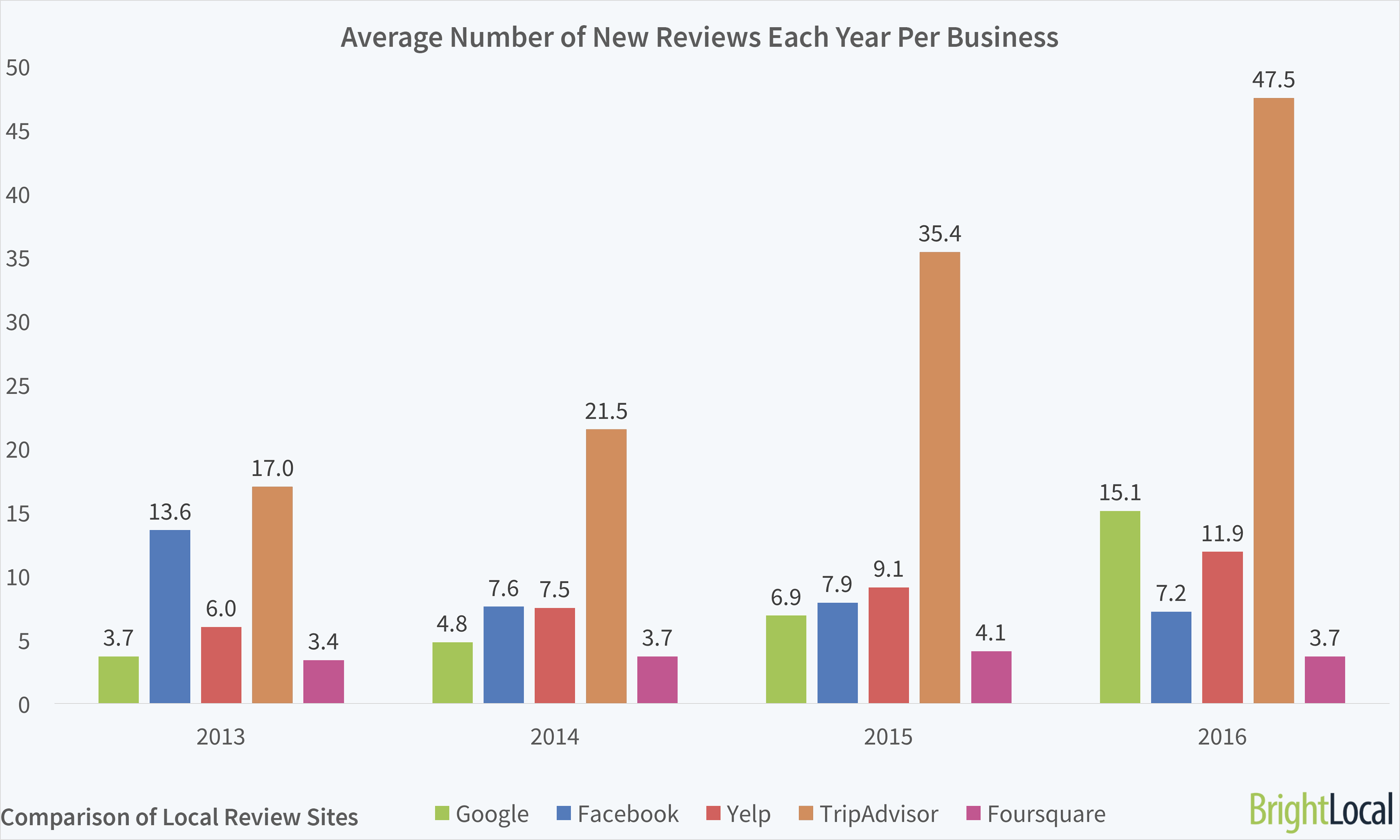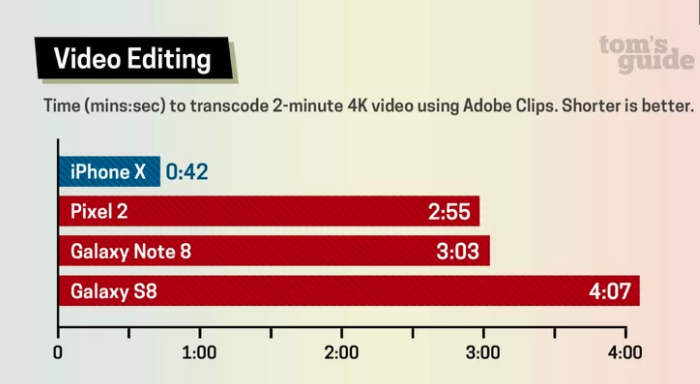Brand Development, Web Design, and Google Analytics Specialists
Experienced in SEM, SEO, Social Media, and Traditional Media
The Top 11 Benefits of Guest Blogging

* Original article *
Guest blogging is one of the best online marketing strategies you can invest in.
If you want to spread your brand’s message and win the trust of your target audience, start contributing content to other blogs related to your market or niche.
Not convinced you should work hard writing content for someone else’s site?
You should know that guest blogging offers many major benefits – both for your company and you, personally.
Here are the top 11 benefits of guest blogging.
1. Instant Exposure to Targeted Traffic
Regardless if you whether you get a link to your site, contributing to other blogs should pique your audience’s interest. If you manage to write a top-quality post, expect traffic to start flowing to your site once it goes live.
Traffic is the lifeblood of any online business or blog. Something as simple as a guest post can potentially translate into sales if you do it the right way.
Optimize your website’s landing pages, CTAs, and other elements to boost your chances at conversion.
2. Expand Your Personal Network
There was a time when connecting with influencers was extremely difficult. But with guest blogging, the process is now simple.
For example, some websites that accept guest posts foster a community of contributors engaged in related niches. In some cases, you’ll get the chance to take part in an email thread where contributors brainstorm potential topics. You can also collaborate with others for co-authored posts.
Regardless of what the community’s structure in a particular site is, you can always leverage your authorship. Seek partnership opportunities with influencers – from content cross-promotion to expert interviews.
All you need to do is be active in the community. Leave comments, share other posts, or cold-email your prospects. If possible, you can even invite influencers as contributors to your own blog.
3. Stimulate Social Media Shares
Generating social media shares is one way to exponentially extend your online reach. The more shares your branded content gets, the more shareworthy it’ll be in the eyes of your audience.
If you’re submitting a guest post to a blog with plenty of social media activity, then shares should come naturally once your content gets published.
To get the ball rolling faster, consider embedding highly shareable content in your guest post. Infographics, for example, can help you get 3x more engagement in social media than any other type of content.
4. Grow Your Social Media Following
Guest blogging not only increases the amount of social media shares to your content, it can also boost your follower count and accelerate your lead generation efforts.
By contributing to an authoritative blog, you are essentially getting them to vouch for your brand. This makes you look good in the eyes of their followers.
In most guest blogging arrangements, you also get to customize your contributor profile. Here you can include links to your social media accounts.
All these benefits will make it easier to win your target audience’s trust and turn them into active social media followers. Remember to reward them by posting regular updates and sharing useful information that aligns with their interests.
5. Improve Your Online Authority
Modern online marketing is all about authority. Even with the best content in the world, it’ll be difficult to convert your audience into loyal subscribers or paying customers if they don’t trust your brand.
By contributing to other authoritative blogs, you get the chance to prove your credibility as an information source. It will make your target audience realize that you’re someone who’s recognized by trustworthy brands. And as a result, they’ll be more receptive to any value proposition you may present in your own site.
6. Fortify Your Backlink Profile
Most blogs that accept guest posts allow their contributors to leave at least one link to their own site. After all, most of them don’t offer any monetary compensation for your hard work. A brief brand mention or keyword-optimized link is the least they could do to reward your efforts.
Still, even a single backlink from an authoritative blog will greatly benefit your SEO. They make your content more discoverable and indexable to search engines like Google. As much as possible, try to target websites in your own niche to build relevancy.
7. Grow Brand Awareness
Guest blogging is a great way to establish your authority in your niche.
As much as possible, try to share practical tips that aren’t already found elsewhere.
Leverage the opportunity to let them know what your company does and how it would solve problems.
Also, be sure to instill your brand’s voice into every single post you submit. This will make your personal brand more recognizable regardless of where you submit guest posts.
Some popular bloggers, such as Larry Kim, use a conversational and humorous approach to engage readers. They also avoid writing fluff while keeping sentences short and easy to read.
8. Generate Qualified Leads
One of the fundamental steps to a successful guest blogging strategy is picking the right websites.
In addition to niche relevancy, you also need to look for sites that already have a steady stream of traffic. This will help you connect with people who are already interested in what you offer as a business.
Always emphasize an actionable step when developing the page that you’re bringing traffic to. It should be related to the guest post you’ve submitted to the other blog. Otherwise, your link is nothing more than a disruption in your audience’s journey — a waste of time for them and a lost lead for you.
9. Shorten the Sales Cycle
The sales funnel has always been a challenge for content marketers. By distributing content through popular blogs, you are immediately building your target audience’s familiarity with your brand. Thus, you are shortening the sales cycle for your products and services.
Think of it this way: rather than waiting for potential leads to come to your site, you can introduce your brand’s value propositions in your guest posts.
You just need to be smart when picking or pitching topic ideas for your guest posts.
10. Get Useful Feedback from the Community
As a guest blogger, another advantage of being active in the community is that you get to receive insightful feedback from other contributors.
When you talk about strategies, for example, other experts may tune in to share their own ideas through the comments section. As a result, you can further develop or refine your strategy with their suggestions in mind.
To invite contributors to comment, try adding a call-to-action in the conclusion paragraph. You can refer to the end of this post to see how it works.
11. Sharpen Your Content Marketing Skills
Guest blogging requires every area of content marketing to be successful. It requires you to do content research, adopt the right writing voice for a particular audience, perform influencer outreach, and so on.
Remember, the best way to learn content marketing tactics is to deploy them yourself. You can’t just read about them, follow everything to the letter, and hope for the best.
By launching your own guest blogging campaign, you’re positioning yourself for growth in every facet of content marketing.
Conclusion
Guest blogging is, without a doubt, a crucial step for online marketing success. Once you grasp its benefits, give it a shot and see if you can make it work for your brand.
10 Podcasts that Will Ignite Your Entrepreneurial Spirit

Podcasts are increasingly becoming a part of our daily habit. No other platform allows audiences to consume educational content while completing other tasks. Marketers, business owners, and entrepreneurs strive to become greater experts in their fields, and podcasts give them the ability to develop professionally even during their daily commute.
We’ve sifted through the endless marketing, business minded, and self-development podcasts to give you the 10 very best. Each podcast dives into varying arenas of the business world. All sure to provide nuggets you can take with you into your personal and professional life.
Let the boost in productivity and inspiration begin!
1. Gary Vee Audio Experience
An amalgamation of the million different podcasts and audio content Gary Vaynerchuk seems to produce these days can all be found in the Gary Vee Audio Experience. Gary believes the future is voice and audio, and so you can expect full throttle, epic content to inspire your work day and motivate you to launch your dream business you once thought impossible. Prepare yourself for unapologetic straight talk when it comes to his thoughts, interviews, and business advice.
2. Social Media Examiner
The Social Media Marketing Podcast is a top-10 marketing podcast hosted by Michael Stelzner and fellow members of the SME team. Episodes feature success stories and expert interviews from industry leaders to help listeners learn new strategies, and actionable tips to improve their social media marketing. Delivered in 45 min digestible weekly episodes every Friday, it’s your go-to for everything Facebook, Twitter, Instagram, and beyond.
3. Smart Passive Income
Who doesn’t relish the idea of making money while you sleep? This is the core concept behind passive income. Of course, there’s plenty of work to be done upfront to get your business soaring, and this is where Pat Flynn steps in. His weekly podcast provides his audience with life-changing strategies and advice for building your online business. Often he interviews business men and women who share their own stories of failure and success.
4. The Joe Rogan Experience
While Joe Rogan is best known for his stand-up comedy and stint as Fear Factor host, he’s also one of the original podcasters that propelled the platform into the colossus that it is today. We included Rogan because of the breadth of guests he interviews on his show. They range from entrepreneurs, musicians, actors, activists, viral sensations, MMA fighters, to political juggernauts. Each with their own knowledge to impart and stories of struggle and triumph to inspire your own journey.
5. The Tim Ferriss Show
As one of the most prolific marketing and business podcasts on the airwaves, The Tim Ferriss Show has consistently been the #1 business podcast on all of iTunes, and has regularly ranked #1 overall amongst 300,000+ podcasts. Each long-form and content packed episode features world-class performers, entrepreneurs, and business leaders to extract the precise tactics, tools, and routines they use so you can adopt into your own life. It’s definitely a can’t-be-missed listening experience.
6. Online Marketing Made Easy
If you’re a small business then you have to listen to Amy Porterfield’s Online Marketing Made Easy. She outlines various marketing strategies by breaking them down into manageable, step-by-step pieces. Ensuring she’s fulfilling her mission to make everything as actionable and profitable as possible. Not only does she provide marketing guides, but also killer expert interviews and intimate behind-the-scene secrets from her biggest launches.
7. The Turnaround – The Growth Show
Half of all businesses fail after five years, and only a third make it to 10. Produced by Hubspot, The Turnaround/Growth Show is a podcast highlighting companies that nearly closed up shop, and instead embarked in a stellar turnaround. Making it a great show for any business struggling with how to grow effectively.
8. The School of Greatness
Hosted by entrepreneur and internet guru, Lewis Howes, The School of Greatness is dedicated to sharing inspiring stories from the most brilliant business minds, world class athletes, and influential celebrities to discover what makes people great. Prepare to self-analyze and feel tested. Both of which will lead to self-growth and success.
9. The Broad Experience
The Broad Experience is a 20 minute podcast conversation about women, the workplace, and success. Hosted by Ashley Milne-Tyte explores everything from race and class to being a professional woman without kids, the difficulty of delegating, and sexual harassment. Outlets like Fortune, Gawker, The New York Times, The Economist, The Guardian and more have praised the show for its storytelling and intelligent discussions.
10. Entrepreneurs on Fire
John Lee Dumas has taken the term “content creator” to the next level. His podcast, Entrepreneurs on Fire (EOF), interviews inspiring and successful entrepreneurs 7 days a week! Everyday you’ll hear from featured guests describing their worst entrepreneurial moments, their AH-HA moments, and what’s working for them in business right now. Over 1,900 interviews have been published with guests ranging from Tony Robbins, Seth Godin, Gary Vee, Barbara Corcoran, and many more.
Email Marketing Segmentation Strategies that Grow Your Business
Email marketing segmentation is a huge boon for businesses. Marketers know segmenting emails into various groupings not only improves open rates, but also click-through rates that ultimately lead to conversions.
Recent data provided by Mailchimp reveals that segmented campaigns receive 14.31% more opens and 100.95% more clicks.
Now more than ever, segmentation is proving to be a greatly effective strategy for businesses looking to drive customer engagement and sales.
It’s All About the Group
Email segmentation is all about the group, and the art of positioning subscribers into groups based upon different factors like: behavior, interests, age, gender, location, and so on. Depending on your industry and goals, the factors will adjust accordingly.

According to DMA, marketers have found 760% increase in email revenue from segmented campaigns. This begs the question, if all your subscribers are different, why are you treating them like they’re all the same?
Established groups should be diverted into buckets fitting the factors you’ve outlined that then serve them specific and curated content and offers they’re most likely to take an action on.
What’s even cooler about segmentation is you can tap into your subscriber’s aspirational self, and not just target based upon where they are in their customer lifecycle. A tactic expertly used by luxury brands.
Segmentation Strategies:
Before dividing up your contact list it’s important to understand a few different proven segmentation strategies. In fact, these are strategies you can immediately adopt today so you can start seeing results tomorrow.
1. Demographics
Demographic data is your launching pad for segmenting your email subscribers into specific lists. Demographic data includes factors like age, gender, income level, company position, education, etc. Seemingly simple demographic data can tell you a great amount about your customer’s wants and needs, and therefore how you can serve them and even turn them into raving fans.
Our recommendation is to acquire as much demographic data from your customer upfront, without scaring them off of course. Whether they’re filling out a form to sign up for your newsletter or are in the purchase process, this is your opportunity to start them off correctly in your email funnel.
For example, if you’re an outdoor retailer, gender is probably at the top of your list so you know which products to suggest to your customers. If you’re a marketing consultant, then knowing your customer’s job title is valuable.
What metrics are the most integral for you business? Be sure to include these in your customer’s signup process.
2. Email Engagement
What better way to sort your customers than by the way they interact with the messages you’re already sending? Segmenting based on email engagement is a simple and effective method that will have a major impact on your results.
Thankfully email marketing services already do a bit of the leg work for us by providing open and clickthrough rates on each email you send. With these metrics you discover your active vs. inactive users.
An inactive user would be someone who hasn’t open an email in three months or more. This is a customer you want to bring back into the fold. Tailor a campaign to re-engage them, whether through a discount offer or a “hey we haven’t seen each other in awhile, check out what’s brand spanking new” type message.
Conversely, you can reach out to your customers that are highly engaged and repeat buyers. We’d call these people your fans. Announce to your fans about an upcoming sale that they’re receiving exclusive first-access to since they’re a loyal customer. If they clickthrough then mark them as “interested” or whatever label you deem appropriate. Then you can develop a specialized campaign to further target them as consistent (maybe even reliable) buyers.
3. Geographic Area
For businesses where geographic location makes a big impact on purchasing decisions then segmenting based on geographic location data is paramount.
A great example of a brand doing this right is Spirit Airlines. Every customer that uses Spirit must filled out basic information like sex, age, and address. The address category is what allows Spirit to target its customers based upon location.
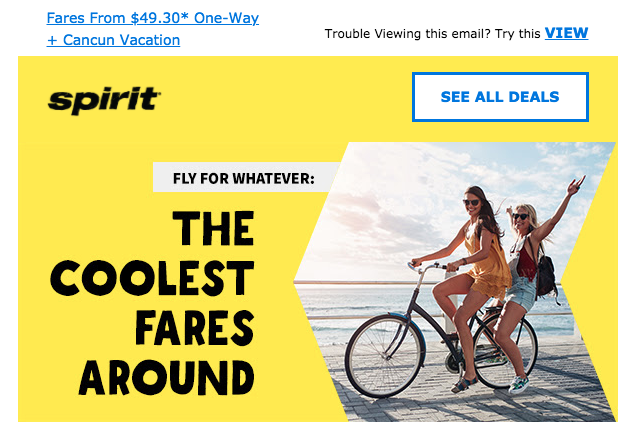
If you’re living in San Diego, why would you care about flight deals out of Denver? You wouldn’t. And this is why geographic location data segmentation is powerful.
Spirit is able to target and supply customers with information, deals, and fun trip facts based upon where you live and where you’re headed. Thus driving open rates and engagement.
Here are a few more examples of ways to use geographic data:
- Location-specific content: Offer a personalized experience by including a specific location in your headline and/or content
- Advertise regional promotions: Offering a Pacific Northwest specific sale? Send focused emails for this promotion to customers in the region.
- Time-based: Send out email at optimum times for customers in different time zones
4. Personal Interest
This is where it gets a little trickier, however if you can pull it off it will greatly help with granular segmentation strategies. You can gain information on your customer’s personal interests by creating user profiles on your website or by using an email subscription center where they can tick off their purchasing or information interests.
You can invite them to do this either in the signup process or encourage them down the road in follow up emails to complete their profile online. Having this information is an amazing tool to help you target customers effectively, and avoid wasting their time with let’s say tech products when their only interest is in beauty products.
In conclusion, email marketing is a highly effective tool that when used correctly can not only nurture your current customer base, but also grow it to unprecedented levels. All you need is a simple email marketing service, knowledge of your customers, creativity, and the drive to build out these segmentation strategies.
Here are a few email marketing services we recommend:
Contact us to learn how we can help your business with email marketing strategies!
Comparison of Local Review Sites: Which Platform is Growing the Fastest?

* Original article *
- Google is the review platform that consistently gains the highest number of new reviews, followed by Facebook, then Yelp
- The average business got fewer new reviews on Facebook in 2016 than before – suggesting a lack of engaged reviewers
- TripAdvisor achieves the most new reviews per business on the platform
- Which ‘local’ review site has seen the greatest and fastest growth in new reviews over the past five years
- How each of these leading ‘local’ review sites has grown year on year, and month by month
- Whether any review sites are experiencing a slowdown of growth
Methodology
We analyzed the review data of approximately 50,000 US-based businesses using data gathered in our ReviewFlow reports. The data set comprises a broad sample of local businesses from many different categories; the data has been aggregated and anonymized.
The data stretches back as far back as online reviews do, but we chose to focus on the past five years (2012-2017) for annual comparisons, and the period July 2016 to July 2017 for a more in-depth look.
We focused the study on five of the most prominent local review sites – Google, Facebook, Yelp, Foursquare, and TripAdvisor. Four of the review sites carry listings and reviews for business in all industries. The fifth, TripAdvisor, was selected due its popularity and prominence in the online review world, and to provide a contrast to the generic review sites.
We chose to include Foursquare because it was once the darling of local-social engagement, and accumulated a lot of reviews and ratings data on local businesses. In recent years Foursquare has pivoted to focus on providing Location Intelligence to help businesses reach local consumers, but they still operate two local-social apps which engage local consumers.
We didn’t look at product or general review sites (e.g. Amazon, Trustpilot) as we are focused on understanding the impact of reviews on ‘local’ businesses (SMBs & Enterprise).
Cumulative Growth in Reviews (2012-2017)
This chart explores the cumulative growth of reviews on the five review sites we analyzed.
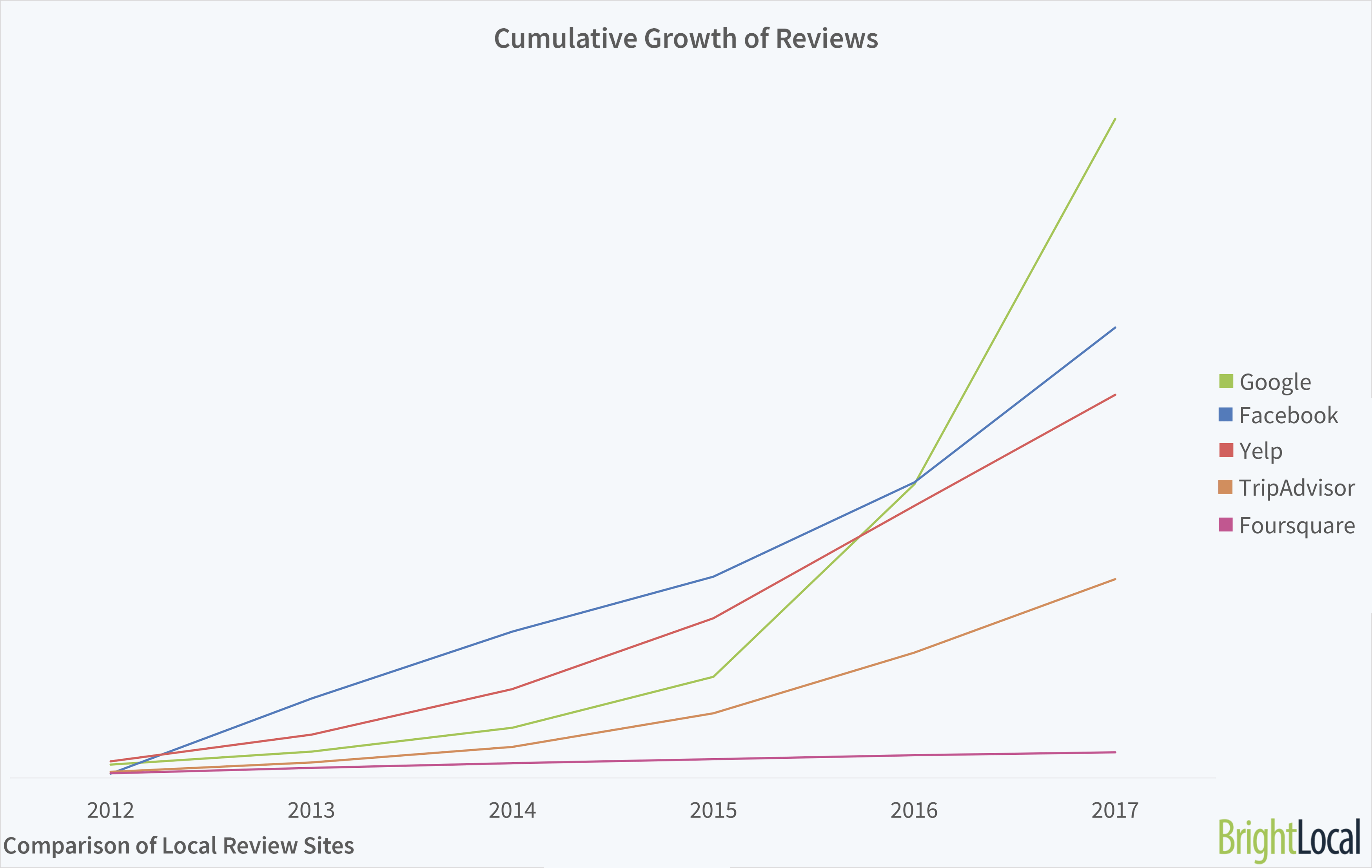
Fastest growing review sites:
- Yelp
- TripAdvisor
- FourSquare
Since 2015, Google has seen the most dramatic increase in the quantity of reviews compared to the other review platforms. Yelp, Facebook and Tripadvisor have all seen an acceleration in their accumulation of reviews – so this is a positive story for all of them – but Google is growing the fastest by far.
Google’s sheer scale coupled with its native integration into Android devices gives them both the biggest audience and the best route to market to prompt users to leave reviews for recently visited businesses. See below for more on this.Foursquare is the only review platform that has plateaued over this period, which isn’t surprising given the company’s change in focus.
Review Growth Compared To Previous Year
This chart shows the percentage growth in the number of new reviews for each site vs the previous year. From this chart we can determine the rate of growth and which site is accumulating reviews the fastest.
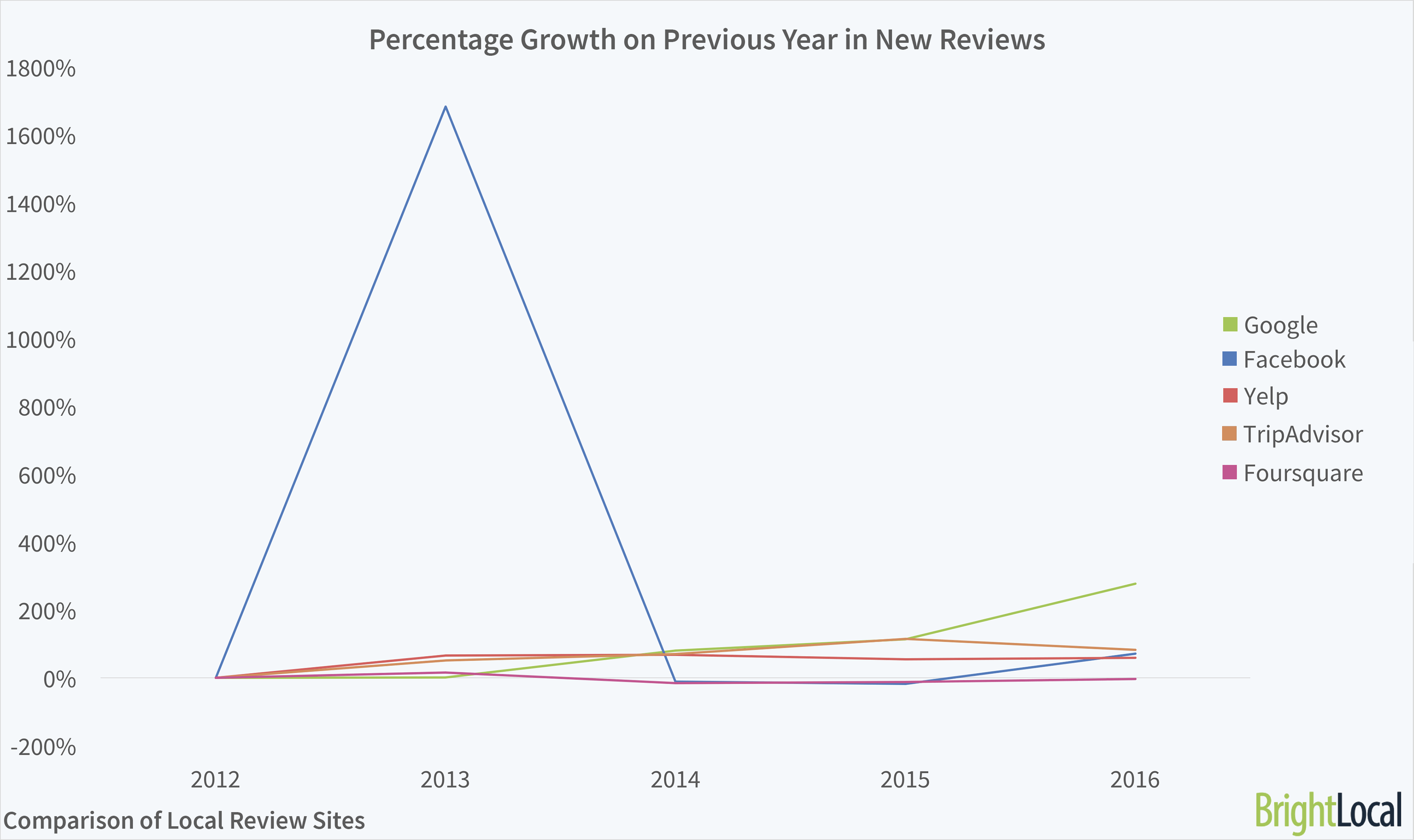
The big story here is the massive jump in new reviews that Facebook saw in 2012-13. This was around the time they first enabled reviews on their service and focused on encouraging users to write reviews, so they saw significant growth from a very low base.
From 2013-2015, Facebook grew slowly, until a big uptick in reviews in 2016.
Review Growth Compared To Previous Year (adapted)
This chart is the same as the one above, but we have ‘flattened’ the spike in Facebook reviews in 2012-2013 to enable us to see the growth in the other review sites.
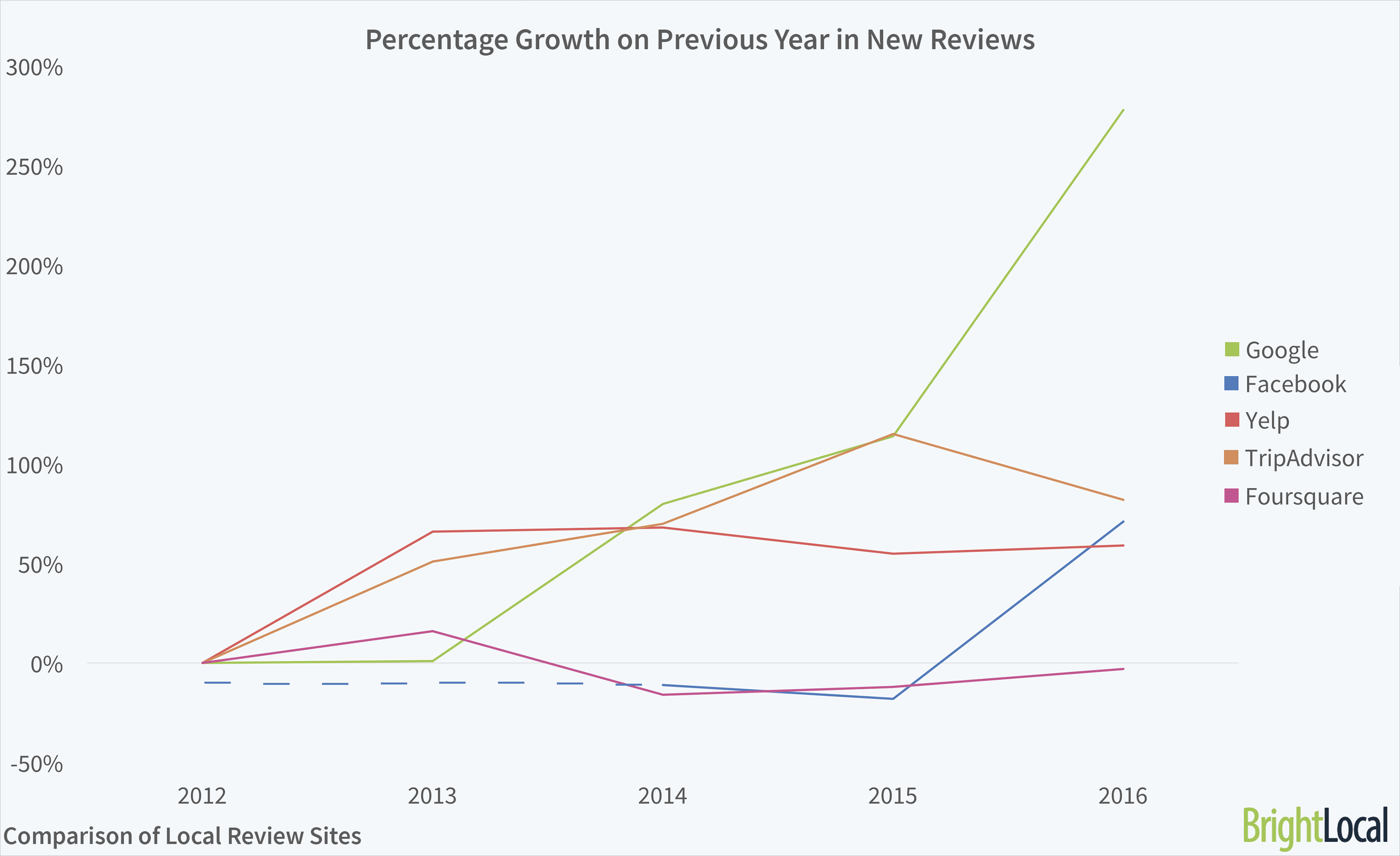
Key Findings:
- Google is acquiring reviews at the fastest rate – new reviews jumped 278% in 2016 from 2015
- TripAdvisor is the second fastest-growing review site – up 82% in 2016 (but slowing from 115% growth in 2015)
- Facebook’s accumulation of reviews was slow in 2014 and 2015, but then it significantly jumped in 2016
- Yelp’s review growth has slowed since 2014 – but is still growing
- Foursquare is the only review site to consistently receive fewer reviews than in the previous year
| Review site | 2013 | 2014 | 2015 | 2016 |
| Yelp | 66% | 68% | 55% | 59% |
| 1683% | -11% | -18% | 71% | |
| Foursquare | 16% | -16% | -12% | -3% |
| 1% | 80% | 114% | 278% | |
| TripAdvisor | 51% | 70% | 115% | 82% |
Average Number of New Reviews Per Business
This chart shows the average number of new reviews gained in each year for a business using the platforms.
When looking at the average number of reviews a typical business has on each platform, TripAdvisor is the clear frontrunner. In 2016, each business in our sample gained an average of 47.5 new reviews – triple the amount the average business on Google received. Read more on TripAdvisor below.
While TripAdvisor may get fewer total reviews than Facebook, Google, and Yelp overall, it receives a far higher concentration of reviews per business across its specialism. Want to find out more about niche review sites for any industry? Take a look at our list of 300+ specialist review sites.
As expected, Foursquare sees the lowest average new reviews per business over the period 2013 to 2016. In fact, the platform has seen little change over this period – peaking at 4.1 new reviews per business, and dropping to 3.4 at its lowest point. It seems like Foursquare is plodding along steadily – acquiring reviews in a consistent scale to the number of businesses using the platform. For more on what’s happening with Foursquare, see below.
Yelp and Google are both adding reviews at scale – having seen increases in the average number of new reviews per business over the last few years. Yelp has been increasing steadily in acquiring reviews per business, growing by around two reviews per year to a peak of 11.9 in 2016. Find out more on Yelp below.
Facebook saw a small drop in new reviews per business in 2016. However, this is not to assume the platform is seeing a downward spiral. Facebook reviews started with a huge jump in 2013, with businesses opting to use this platform receiving an average of 13.6 new reviews each in 2013. In 2016, a typical business received 7.2 new reviews. This decline in average could be down to the high number of businesses on Facebook – with less engagement from users regularly leaving reviews for businesses.
Of course, Facebook’s primary function is as a social network, so leaving reviews can be of secondary importance for users. Clearly, businesses have realized the importance of having a presence on the platform – but the platform needs to encourage users to leave reviews if they are to really compete with Google. Read further trends on Facebook here.
Yelp, TripAdvisor, and Google all have more reviews per business than Facebook – suggesting that these three sites have a more active audience that are engaged and leaving reviews. For Yelp and TripAdvisor, this is likely due to reviews being their key focus – with users only on the site to read or leave reviews.
Google received significantly more reviews per business in 2016 than the previous years – more than doubling new reviews per business (15.1, up from 6.9). Read more about Google here.
Google doesn’t solely focus on reviews, but is an integral part of finding a local business. Mobile location tracking means that Google can send queries to users asking for reviews for places they’ve been. From here, users can easily submit short reviews with photos directly from their devices (as shown below).
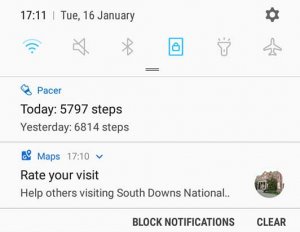
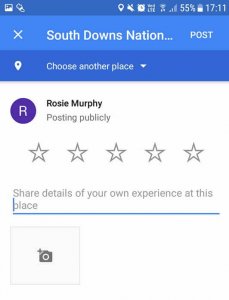 This means users are encouraged to submit regular, ‘everyday’ reviews just because they are asked to – rather than seeking out a business on a review site due to a notably good or bad experience.
This means users are encouraged to submit regular, ‘everyday’ reviews just because they are asked to – rather than seeking out a business on a review site due to a notably good or bad experience.
Number of New Reviews Written Per Month (July 2016 – July 2017)
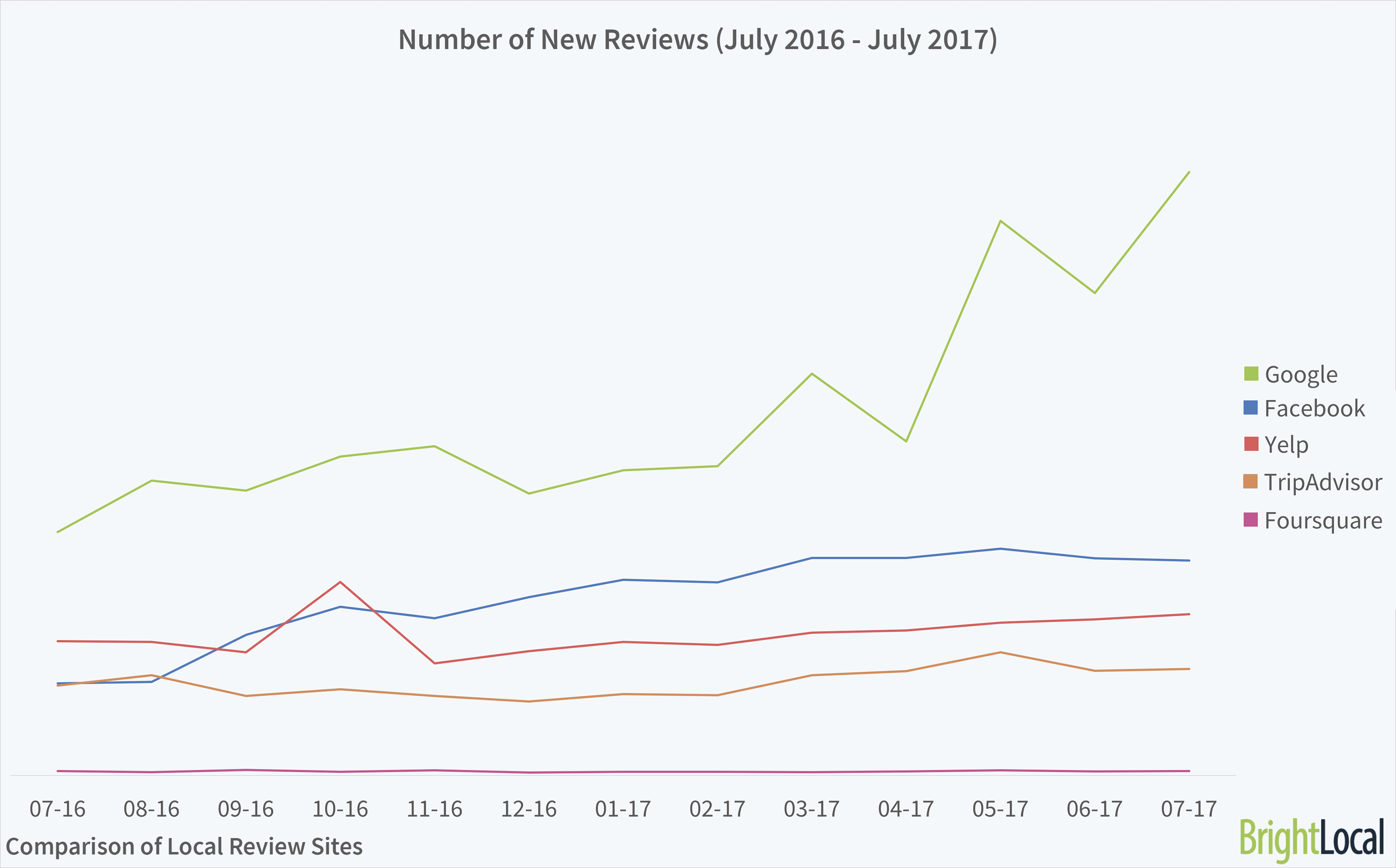
The period July 2016 – July 2017 highlights a number of trends across the review platforms in greater detail. We delved into the number of reviews each platform gained every month in that period.
- Google continued to lead in the number of new reviews – with significant increases in 2017
- Facebook also saw strong growth in this period – but at a slower pace than Google
- TripAdvisor and Yelp grew slowly and steadily
Generally, the months in our time period in 2017 outperformed the months in 2016 – signifying further acceleration of growth for most of the review sites.
Google saw a significant increase in the number of new reviews – pulling quickly ahead to leave everyone else in the dust. It saw a 40% increase from April to May 2017 in the number of new reviews per month. While there was a small drop the next month, this ramped up again in July. By July 2017, the businesses were receiving more than double the amount of new reviews they were just a year before.
On Facebook, the businesses in our sample saw a significant growth in the number of new reviews from September 2016 – growing 33% in just one month. Between August and December, it more than doubled the number of reviews per month – and continued growing in 2017. Our sample suggests that Facebook has lots to be proud of in this time period – growing from a similar number of reviews as TripAdvisor in July 2016, to an increase of 133% a year on.
Curiously, May 2017 proved to be a great month for Google, Facebook, and TripAdvisor. If you’ve got any thoughts on why this might be, leave us a comment below.
Perhaps unsurprisingly, there appears to be a summer peak for TripAdvisor, with August, July and October leading in 2016 – although the months March to July 2017 outperform every month in 2016. It’s no surprise that this correlates with the high season for holidays and trips out.
Yelp received a steady number of reviews – performing well throughout the time period with a surprise peak in October 2016 that even overtook Facebook for the month. It soon dropped back to its former position, with a slow and steady increase in the number of reviews each month.
Foursquare was the only platform of the five that didn’t show a clear trend of increased reviews over the time period. But with these numbers being a fraction of their nearest competitor, the lack of correlation is not a shock.
Trends by Review Site
Google Reviews

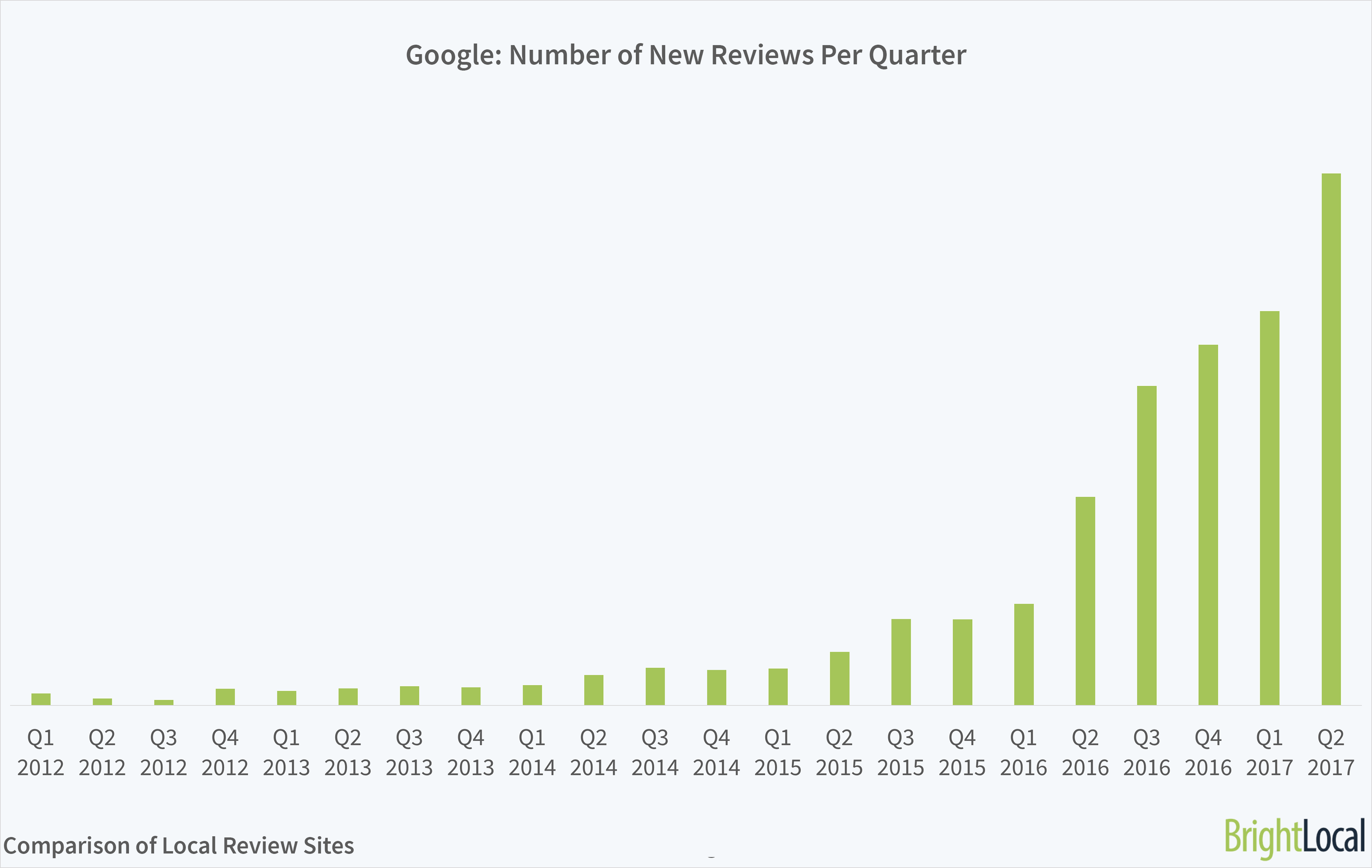
Google has told an interesting story, placing third for number of reviews in 2014 and 2015, and jumping into pole position from 2016. The businesses in the study saw a huge uplift in reviews in Google – seeing an increase of 278% in 2016 from the year before, and acquiring significantly more in the first half of 2017. While it may have had a slow start, the powerhouse is growing every quarter to lead in numbers of reviews.
From the days of Hotpot, Google has placed itself as a source of recommendations. So much information is now available in SERPs and the Google environment, it’s no wonder reviewers are choosing the platform that is so useful and prominent during the research process.
Google’s stellar growth should be attributed to its growing omnipresence. It’s become a normal part of finding local businesses, and makes it incredibly easy for people to leave reviews.
However, our recent Local Consumer Review Survey found that Google is consumers’ third most trusted review site – behind Facebook and Yelp. While our Review Growth data shows Google’s rapid growth to becoming the leading platform in number of reviews, there’s still work to be done in aligning this with the trust of users.
Facebook Reviews
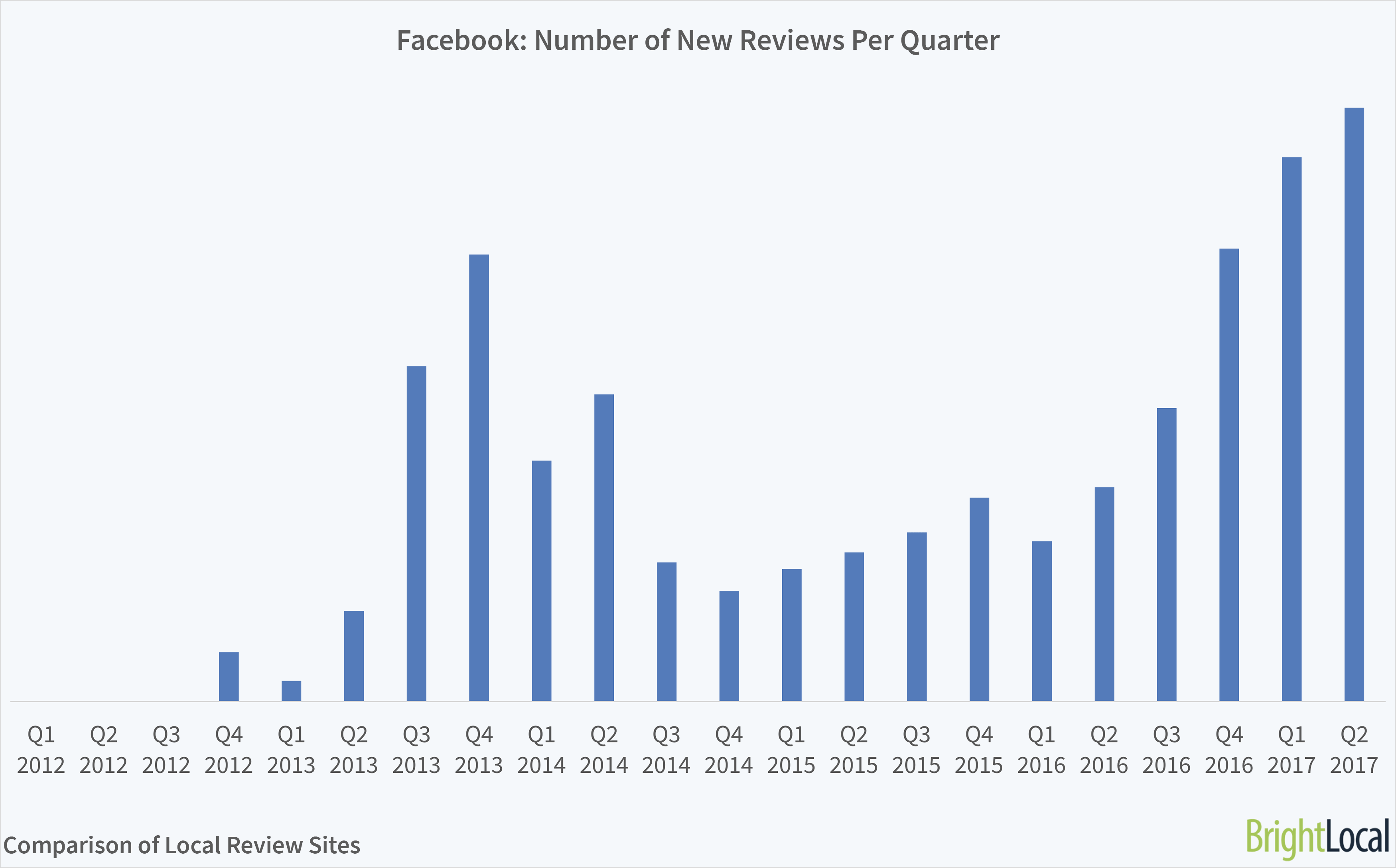
Facebook reviews rapidly took off following their introduction in late 2012. The December 2012 announcement of Nearby meant users could share their recommendations easily with friends for the first time, explaining the rapid percentage growth as seen in 2013.
In 2013 and 2014, Facebook led on reviews – with businesses clearly clamoring to be on the popular platform. But from 2015, Facebook could no longer rely on being the most popular source of reviews.
Don’t worry though, Facebook isn’t failing – it’s just growing at a slower rate than frontrunner Google. By November, Facebook had achieved growth of 64% on 2016. It’s not losing out as more consumers turn to Google – but could begin to receive fewer reviews in 2018 if it doesn’t encourage users to share their views.
Facebook’s recent news feed changes could affect the visibility of publishers and brands, and instead give more prominence to posts that generate discussions. This could affect which businesses users see. This could mean local businesses need to increase Facebook paid advertising, or turn to the Facebook Local app to continue being seen on the platform by potential customers.
Facebook Local is a separate app which has so far seen limited success. The Google Play Store estimates downloads as between 100,00 – 500,000 (January 2018) – far lower than Yelp’s 10-50 million Android users, or TripAdvisor’s 100-500 million. It will need to reverse this trend to continue to be a trusted platform for reviews.
Yelp Reviews
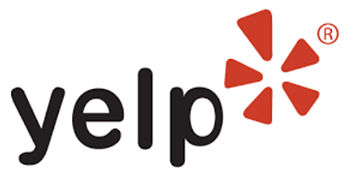
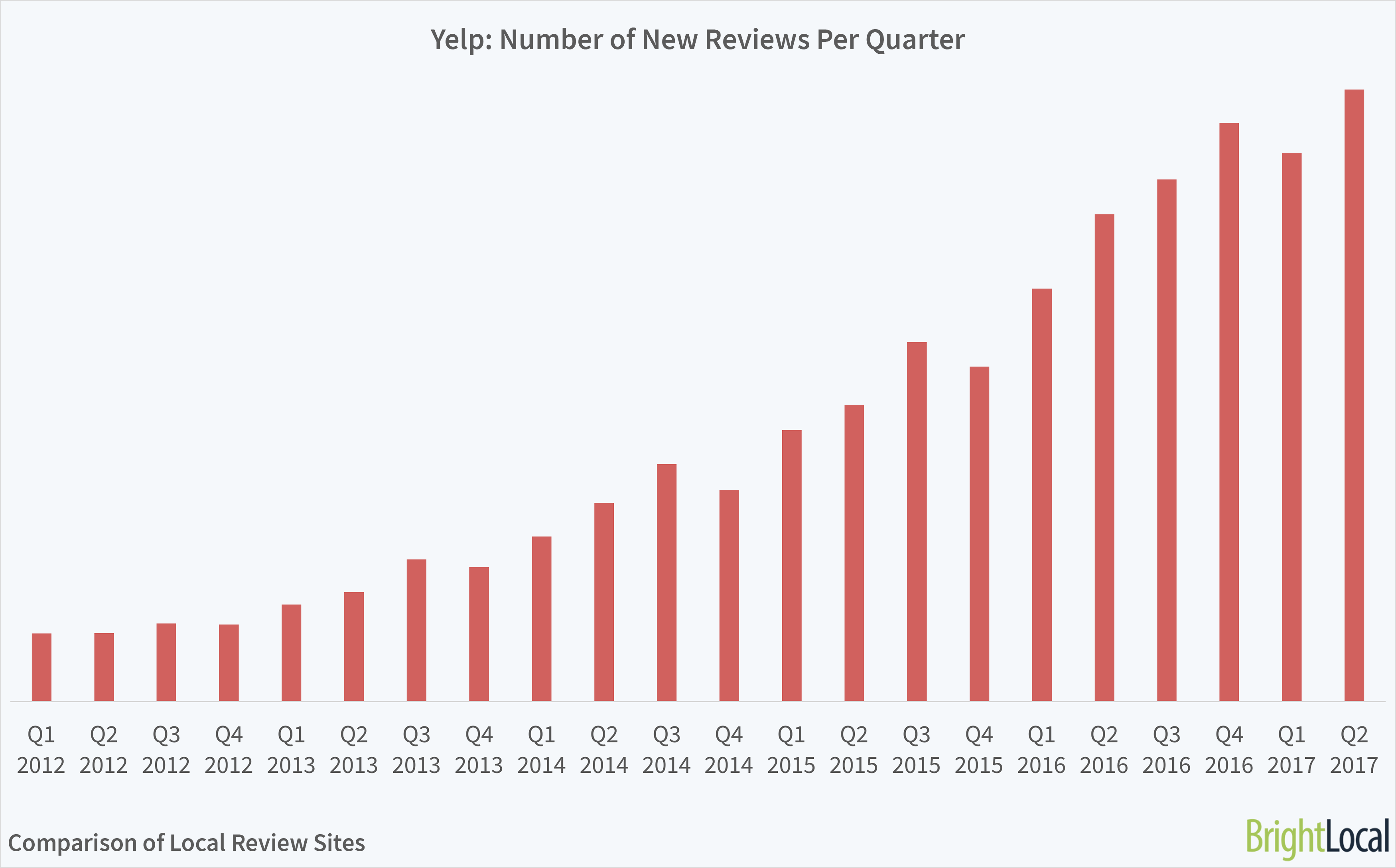 Yelp has been a steady performer over the years, but its growth appears to have slowed recently. In each year prior to 2017, Yelp reviews grew between 55% and 68% on the previous year. It received fewer new reviews in Q1 of 2017 than in the previous quarter, although this did grow again in Q2.
Yelp has been a steady performer over the years, but its growth appears to have slowed recently. In each year prior to 2017, Yelp reviews grew between 55% and 68% on the previous year. It received fewer new reviews in Q1 of 2017 than in the previous quarter, although this did grow again in Q2.
2016 was a difficult year for Yelp, with the platform announcing a scaleback in operations outside North America, and culling further international expansion plans. In May 2017, Yelp’s stocks dropped by 30%after showing disappointing sales.
These recent difficulties appear to be in line with the smaller growth in new reviews – and could indicate that Yelp have recognized their troubles ahead of the review downturn. But, it’s not all bad news, as it is still growing – albeit at a slower rate – with May, June, and July 2017 each surpassing every month before in the number of reviews received on the site.
The big news from Yelp in 2017 was its firm stance on businesses asking for customer reviews. While authenticity should be paramount to any review strategy, actively discouraging asking for these could result in Yelp receiving fewer reviews going forwards. It’s highly possible that businesses will turn to other review sites, rather than stopping asking customers to leave reviews at all.
Tripadvisor Reviews
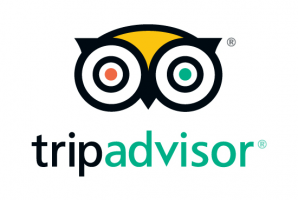
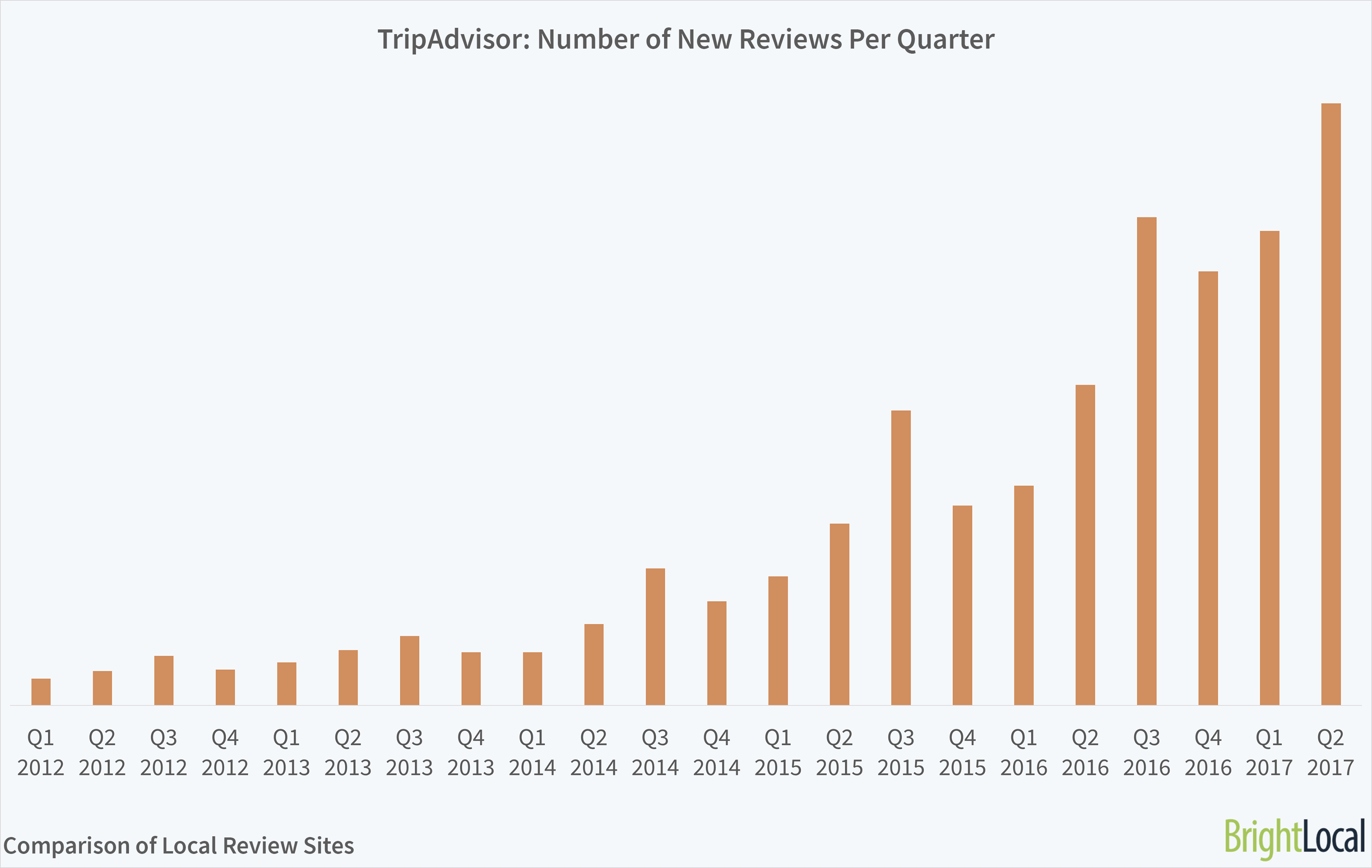
Due to its niche focus, it’s no surprise that TripAdvisor doesn’t acquire as many reviews as Google, Facebook, and Yelp. The travel specialist appears to be slowing in percentage growth – but it is still growing! In 2015, the number of reviews grew 115% on the year before, and a further 82% 2015-2016. It had a particularly strong Q2 in 2017 in the number of new reviews.
As a business, TripAdvisor had a tumultuous 2017, with results falling below analysts’ estimates. The Financial Times reported that “TripAdvisor shares have declined 15 per cent so far this year amid concerns that the company will struggle to turn audience growth into revenue growth.” It’ll be interesting to see if these difficulties reflect in future new reviews on the platform.
Niche review sites may attract fewer total reviews than the big three review platforms do, but they’re still incredibly important within industry sectors. Local businesses should ensure they receive reviews across each of the relevant platforms – making sure to consider where their customers and audiences are looking to find out more.
Foursquare Reviews

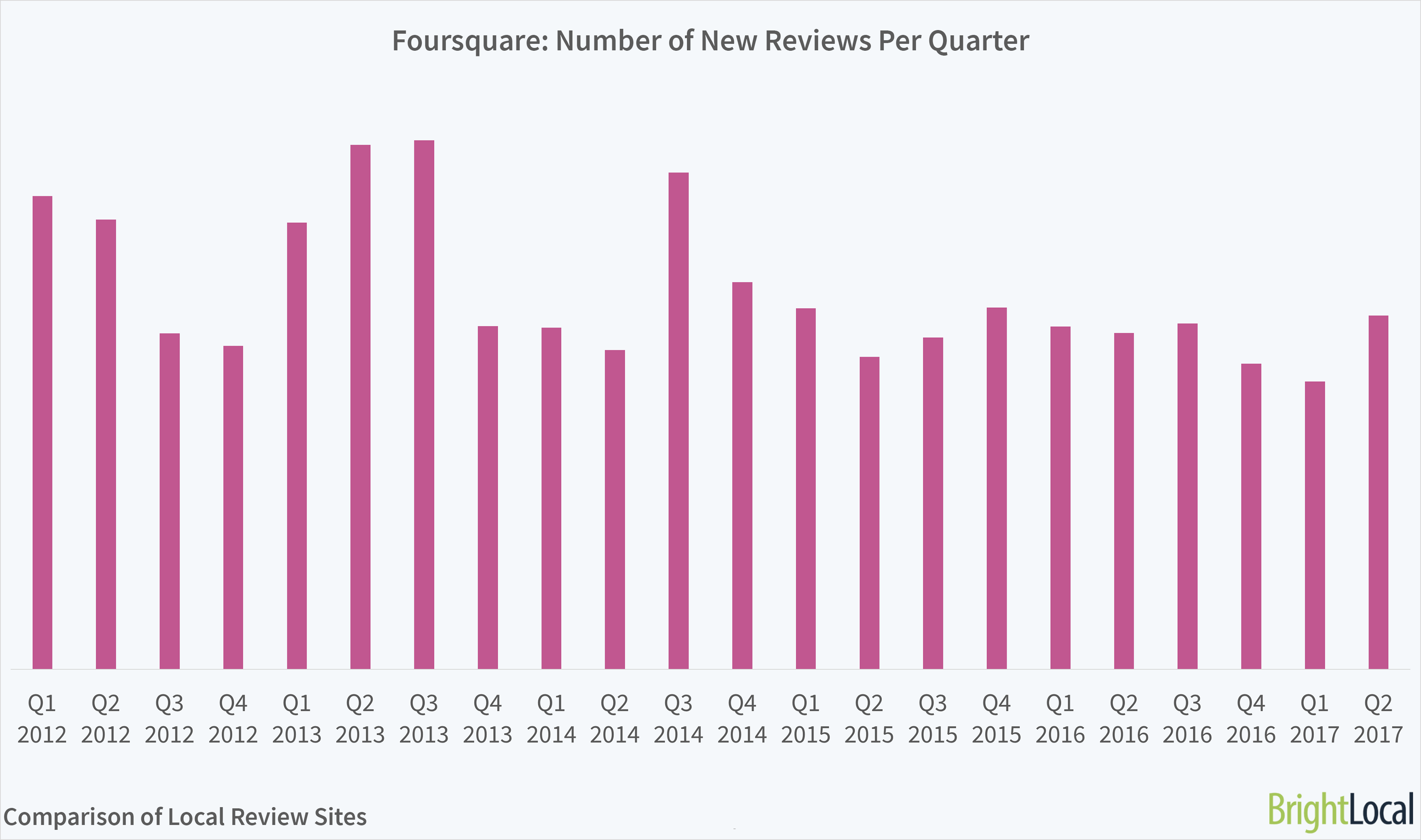
Foursquare’s comparatively low reviews rates will come as no shock. While it no longer competes as a leading reviews platform, it instead excels with its incredibly accurate location data. There have been predictions about Foursquare ending its focus on consumer recommendations, and instead selling its significant data set. Its future remains to be seen.
Loyal users of City Guide can use Foursquare’s data set to find recommendations where they are – although clearly there are fewer reviews per business than other platforms offer. The average consumer reads 7 reviews before trusting a business, so Foursquare might not be the place to go to receive sufficient information.
How Traditional and Digital Marketing Work Together to Power Your Business Goals

Traditional marketing has drastically changed through the evolution of the digital age, and the societal integration of social media. The past 15 years of revolutionary change has caused confusion, doubt, and misunderstanding. Leaving many marketers in the lurch as they attempt to navigate in an ever-changing advertising landscape.
As a result, some are ditching traditional methods completely in hopes of online techniques bringing them holy grail-like ROIs they once experienced. According to Above the Fold’s Traditional Media Strategist Charlie DeNatale, “Traditional media is not broken. What needs to be fixed is the mindset change of what traditional media’s role use to be and what its role is today.”
While digital media strategy is highly important and necessary for producing results and to compete, using a combination of traditional and digital marketing techniques is proving to be the most effective method to elevating success.
The combination of traditional and digital is a one two punch for driving awareness and sales. When combined, they compensate for each other’s weaknesses and so the benefits of both plans are gained as they work in synchronicity.
How to Marry Traditional and Digital Marketing
1. Multiple Channel Approach
By taking advantage of a wider range of traditional and digital techniques, you’re putting your company’s message in front of a diversified audience. For example, a placement during on a cable network like the Hallmark Channel will most likely reach an older audience, while a placement during a teen drama on Hulu will hit a chord with a younger audience.

Depending on the target, some media outlets and types are more successful than others, especially when you consider that a younger audience is more digitally savvy than say their parents’ generation. Using both methods allows your company to reach the full spectrum of potential customers.
One brand that seamlessly integrates both a traditional and digital strategy is fast food chain, Wendy’s. Through their social channels they’ve built a rabid following, eager to consume and interact with the brand through their regular roasting of competing brands and Twitter followers. Their savage tweets have brought a whole new generation of Wendy’s fans and patrons into the fold. They also regularly utilize traditional channels like TV commercials, print, and billboards to attract new and old customers to their restaurants.
2. Segment Campaigns by Active & Passive
Figure out first what your company’s objectives are with your campaign. Is it brand awareness? Driving sales to a new product offering? Introducing your brand to a new generation?
Then you can segment your campaign strategy based upon the activity of the consumer. Traditional marketing is considered to be passive, while digital marketing involves targeting a specific audience, making it active.
While they may be segmented by audience or purpose, they can still maintain a common thread to boost the success of the campaign’s overall goals.
One common thread could be a hashtag. Ask your social followers to take a picture with your product and use the hashtag to be featured or win a contest. Place this same hashtag in our traditional media placements to spread it far and wide, giving it visibility beyond the digital sphere.
3. Get Personal
The amazing result of digital marketing is how its given brands and small businesses the ability to connect with consumers at a deeper personal level. Gone are the days where a customer has to go through the customer service department to get a question answered or a problem resolved. All they have to do is leave an Instagram comment or Tweet at the business and typically within no time they’re getting a direct reply from the company; building trust and affinity.
With social media’s personal touch it’s now more important than ever to have a strategic approach when considering traditional media. Not just what you buy, but how you buy it, how it supports a digital campaign and the influence it has on SEO, PPC, website traffic, and sales.

A great example of a company using traditional and digital to get more personal with their consumers is online fashion retailer, Asos. They release a regular Asos Magazine that features not only their latest fashions and product offerings, but articles related to pop culture, rising stars and musical acts, and other millennial targeted pieces.
Every item featured in the magazine can then be found on a dedicated page titled, “Shop the Asos Magazine.” This gives the reader the chance to emulate their favorite starlet or take the look from the page, and wear it in real life.
It’s a strategy that’s working. Especially when coupled with their hashtag #asseenonme, which encourages their followers to use the hashtag with their Asos look for a chance to be featured on their 6.7M follower Instagram account.
How good is the hashtag working? To the sound of 676,609 photos and counting. Getting personal is the key to building a cult following, or at the very least an audience that’s dedicated to your brand.
In the End, Take a Holistic Approach
Shrewdly evaluate your current traditional and digital efforts with a holistic approach. Understand the “Balance” of your budget allocation between traditional and digital. Use the techniques together to create a cohesive marketing strategy that drives tangible results for your business. If you’re not using both than your business may not be attracting all of your potential customers.
Above the Fold can help you apply these techniques and develop a strategic traditional and digital marketing plan. Contact us today at 760.613.1212 to learn more!
iPhone X vs Pixel 2 XL: Which One is Right for You?
With the anticipated release of the iPhone X it has many thinking, is the crisp OLED screen and Face ID technology worth the hype and biting the $999 bullet? We’re looking past the hype and sticking to the straight up facts.
Now we haven’t personally tested the iPhone X and Pixel 2 XL, however we compiled all the important specs and testimony from journalists who have spent time with each phone. Thereby giving an unbiased view behind the hardware, design, and capabilities.
From there you can decide for yourself, are you team Apple or team Android?
The Specs You Need to Know
To the average smartphone user it’s difficult to fully grasp what the tangible differences are between the iPhone X and Pixel 2 XL. So we created this handy dandy cheat sheet for your reference, and even included the iPhone 8 as your cheaper powerhouse alternative to the shiny new toys in the market.
![]()
Design Differences
The iPhone X’s design is so beautifully crafted that if Steve Jobs were here today, he’d give it a standing ovation. Aesthetically, the Pixel 2 XL leaves much to be desired.
iPhone X: The notch, the section at the top of its display that holds the camera, has received a bit of flack for its encroachment into the screen. Despite the necessary evil that is the notch, the overall design is seamless, crisp, and a full 360 degree beauty. The back is made of glass to allow for wireless charging, and the stainless steel sides give it the grip it needs.

Pixel 2 XL: As is the case with the majority of Android phones, the overall design feels rather uninspired. It features a two-toned aluminum back with a satisfying grainy feel that’s sure to provide excellent grip.
![]()
Both chose to continue the trend away from a headphone jack, forcing users to adopt a wireless lifestyle or adapters (just don’t lose it!). Apple and Google’s phone’s use different charging cables. Lighting or wireless for iPhone, and USB Type-C for the Pixel.
OLED Comparison
Apple has finally moved to OLED, a feature Android beat them to when Samsung released their Galaxy S II.
iPhone X: Apple’s screen is a 5.8in display at an extra tall 19.5:9 aspect ratio, and at 2436×1125 (458 pixels per inch), it’s a step up from the already-crisp iPhone 8 Plus panel (a 5.5in 1080p LCD).
It’s an exceptionally bright phone, emitting up to 574 nits, which helps the iPhone achieve much wider viewing angles. Additionally, it offers more accurate hues; it registered a Delta-E score of 0.21 (0 is perfect).
Pixel 2 XL: Google has Apple beat on sharpness, with its 6in, 18:9 OLED display coming in at 2880 × 1440 (538 ppi). The brightness sits at 438-nit and registered a Delta-E score of 0.28.
Recent concerns over the Pixel’s OLED burn-in has led Google developers to swiftly remedy the issue. Google claims its November 6th update will fix the issue with the introduction of a “fade out” for the on-screen navigation buttons and an adjustment to the screen’s brightness.
Performance
What’s behind the chart? iPhone X’s A11 Bionic processor took only 42 seconds to transcode (convert) a two minute 4K video in the Adobe Clips app. Pixel 2’s Snapdragon 835 chip took an additional 1:13. A time different that’s difficult to ignore.
Camera Capabilities
According to Tom’s Guide’s testing, “The Pixel 2’s and iPhone X’s cameras are both great, but each has its own strong suit.” While Stuff.tv is fully team Pixel with the claim that “Shots are realistic and packed with detail, cramming in loads of dynamic range. The results don’t look overwhelmingly sharpened or too-vivid-to-be-true: they just look phenomenal and lifelike.”
iPhone X:
- 12MP shooters (f/1.8 wide angle and f/2.4 telephoto)
- 2x optical zoom from dual rear cameras
- Captures more natural skin tones
- Optical image stabilization
- Better low-light shooting
- Better HDR shooting
- Portrait mode
Pixel 2 XL:
- Superior low light photos
- Portrait mode
- Portrait lighting feature
- 12MP f/1.8 back camera
- Optical and electronic image stabilisation
- Dual-pixel PDAF
- Laser-assisted focusing
- Crisp vibrant colors
- Digital zoom
Battery Life: Which one lasts longer?
On the Tom’s Guide battery test (continuous web surfing over LTE), the iPhone X lasted 10 hours and 49 minutes. The Pixel 2 XL lasted for 12 hours and nine minutes, leaving the iPhone behind by over an hour. Giving Google’s phone the ultimate endurance.
Special Features
Both phones offer their own range of special features. Whether you’re more keen on higher level security or daily assistance, these phones have exactly what you want, and what you may realize you need.
iPhone X: Apple has taken biometric security to the next level with its Face ID feature. Face ID scans all dimensions of your face, and if it’s a match the phone will unlock. This same technology is used for Animoji, cute and impressive characters that come to life based on your expressions and voice.

Pixel 2 XL: The big winning feature is Google Assistant. It’s the smarter faster version of Siri that’s not easily confused by your queries. And all you have to do to summon Google Assistant is to squeeze the bottom of the phone.
So what’s the bottom line? The race between iPhone X and Pixel 2 XL is neck and neck. To make the ultimate decision it may come down to price, aesthetic, or even the need to be an Animoji. We’ve given you the facts, now it’s decision time.
27 Free Marketing Tools that Actually Grow Your Business
When performing a simple search for a variety of marketing tools you’re sure to churn out what seems like a billion options. After going through a few in each category it can feel like you really can’t go wrong with any of the tools. Especially when they’re lauded with endless reviews from Fortune 500 companies or the most relevant marketing guru.
What’s more, many of the available marketing tools come with a hefty price tag that just isn’t feasible quite yet for startups or small businesses.
Thankfully we’ve removed much of the guess work and analyzed dozens upon dozens of tools, all with the price tag of $0 so you’ll know straight away what to invest your time building into your marketing strategy.
Social Media Scheduling
1. Later: If you’re using Instagram heavily for your business’ products and/or services then you need Later in your life.
With capabilities like visually planning and scheduling 30 posts monthly, all of your workflow is kept in one super organized place. The Visual Instagram Planner enables you to flawlessly curate the layout of your feed (our favorite feature)!
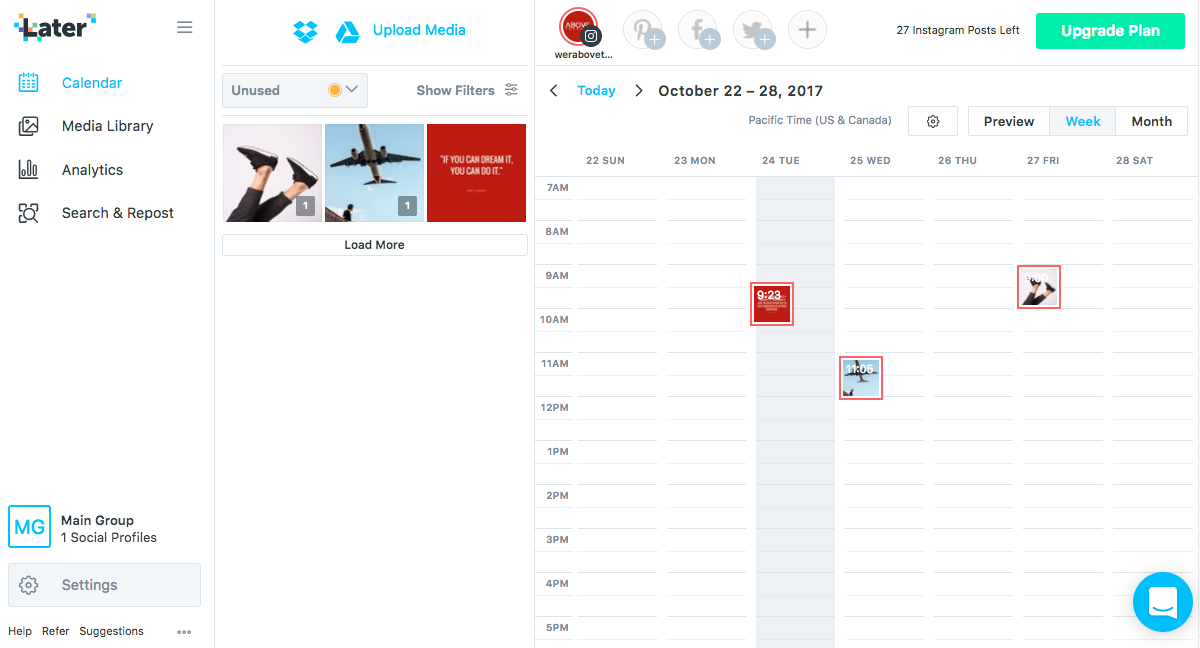
If you’re able to upgrade to pro then you’ll be able to utilize Linkin.bio, which gives you the capability of having multiple links in your bio. Additionally, pro allows you to post across Facebook, Twitter, and Pinterest.
Don’t want to pay for the Linkin.bio feature? Then Linktree is an awesome and FREE alternative.
Other great options:
- Buffer: The forever free plan lets you connect one profile from Facebook and Twitter, and schedule ahead 10 posts for each network. Meaning, if you share three posts per day you can stay three days ahead all the time.
- UNUM: Another great way to plan the look and feel of your Instagram feed. While also gaining simple analytical insights into the performance of your posts. You’re only allowed up to a certain number of planned posts before you have to upgrade.
Hashtagging
We’ve all been there… staring blankly at our phones after copying and pasting our usual hashtags. Wondering if there are any other ones out there that can serve us better. Or maybe you’ve struggled with the infamous shadow ban. The following tools will help you on both fronts.
2. Display Purposes: With Display Purposes you can discover related hashtags three different ways: through search, localized map, and graph. Just enter the hashtag you generally utilize and watch as the magic happens.

3. Focalmark: This app for iOS and Android operates similarly by allowing you to search and find related hashtags. Since it’s app based you’re able to seamlessly copy and paste to Instagram.
4. Shadowban: Test your recent posts to see if the hashtags you’re using are getting you banned from being discovered. Probably one of the most useful tools out right now!
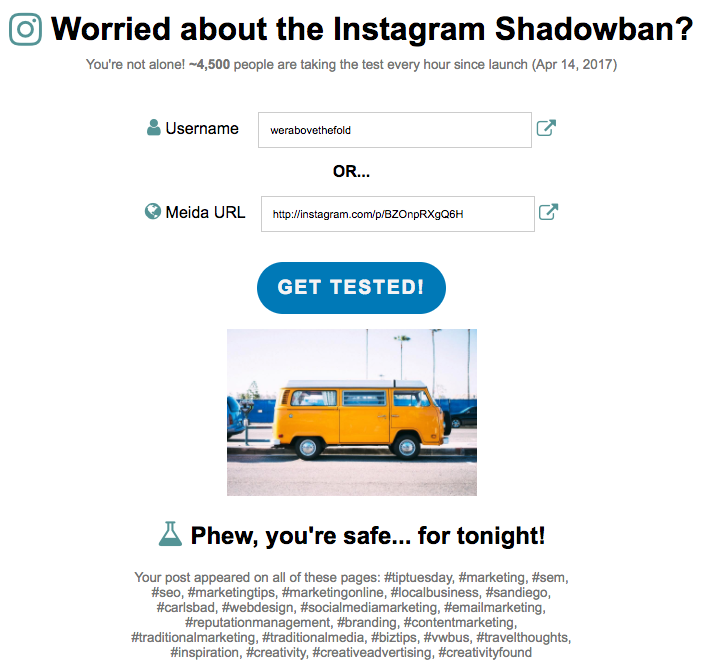
Free Images
4. Unsplash: One of the most robust and beautifully curated free image sources on the Internet. With pictures being added daily you can easily find the perfect capture for your next marketing campaign, social, or blog post.
We use Unsplash often for imagery used in our blogs post and social.

5. Pexels: Another great source for free stock photos.
Photo Editing
6. ColorStory: Eye popping color and beautifully crafted presets with robust editing tools.

7. VSCO: One of the world’s go-to photo editing apps. We love using them as part of the overall editing process.
Other Paid Option:
- Afterlight: Another great editing app if you’re looking to get more granular with your edits, instead of relying only on filters and gimmicks.
Design
8. Canva: Over 2 million people use Canva to create stunning images for social media, blog posts, Facebook ads, landing pages, and so much more.
It’s a wonderful resource for businesses with limited design budgets or even know-how. The optimized sizes and templates make it easy to develop content for every social platform in a really imaginative a deceptively skillful way.
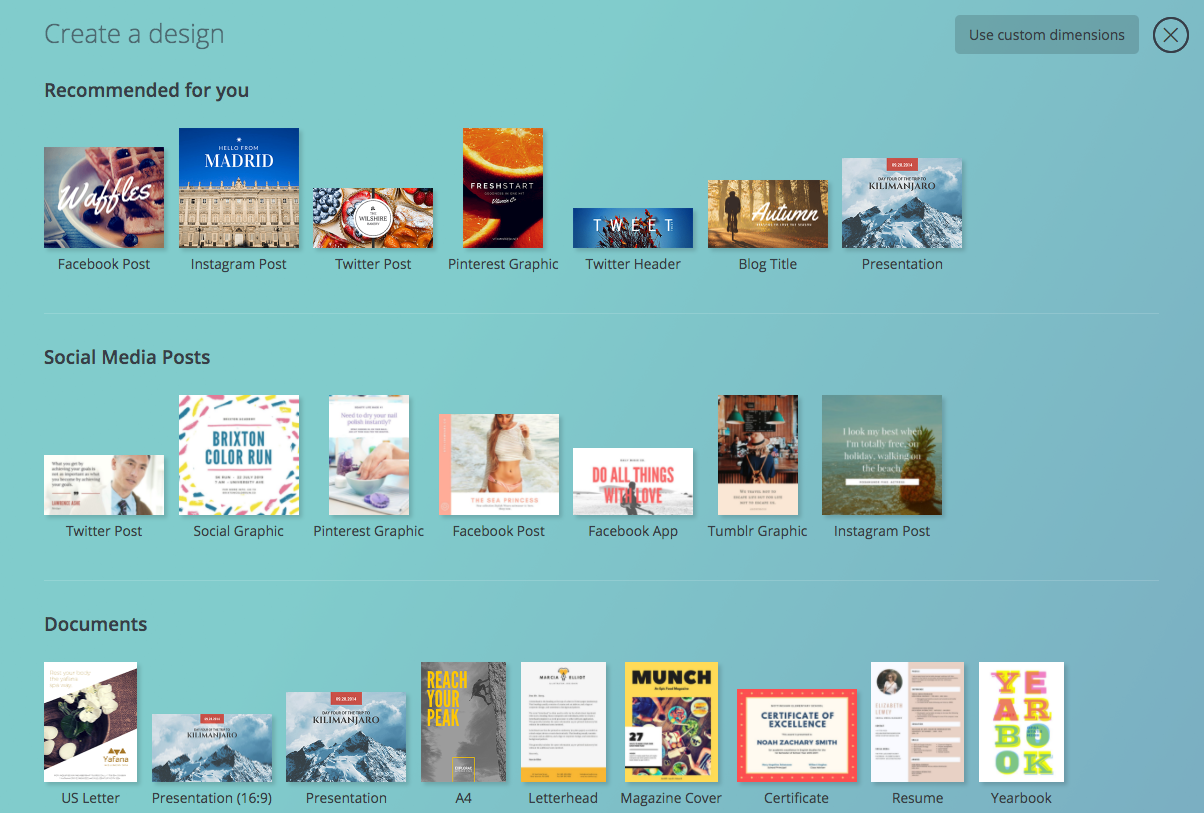
Influencer Marketing Related
9. Influencer Money Calculator: Every wonder how much a particular influencer is really worth or if you’re over spending on your influencer marketing campaigns?
Then head over to Influencer Marketing Hub’s money calculator, which provides an estimate on how much to pay influencers for a campaign.
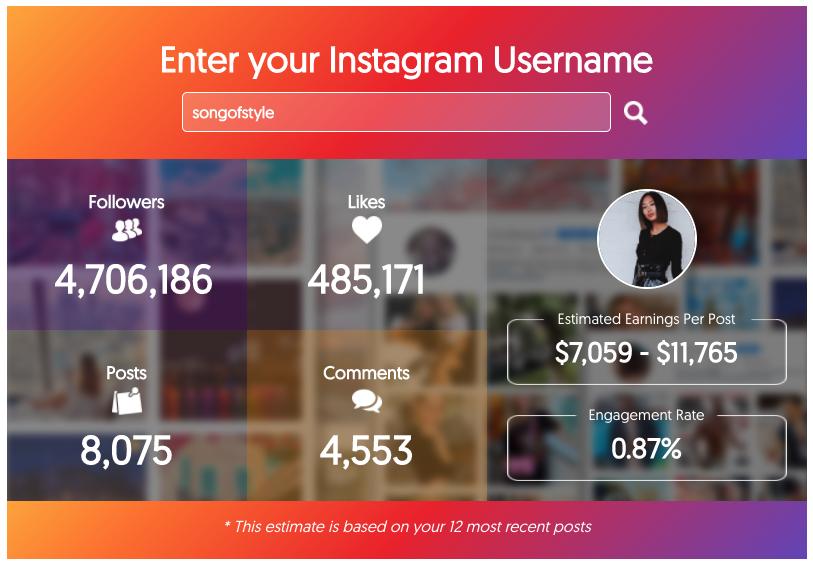
10. Klout: By using social media analytics to rate its users according to online social influence via the Klout Score, they’re able to place a numerical value between 1 and 100 on an influencer. Use Klout as part of your influencer selection process.
Generating Content Ideas
11. Buzzsumo: Whether in a blog post idea drought or trying to gage what content performs best for a specific topic, Buzzsumo is your place to figure it all out.
They allow a few searches for free, but afterwards will require an upgrade to pro so we suggest a targeted search if you can’t afford the service quite yet.
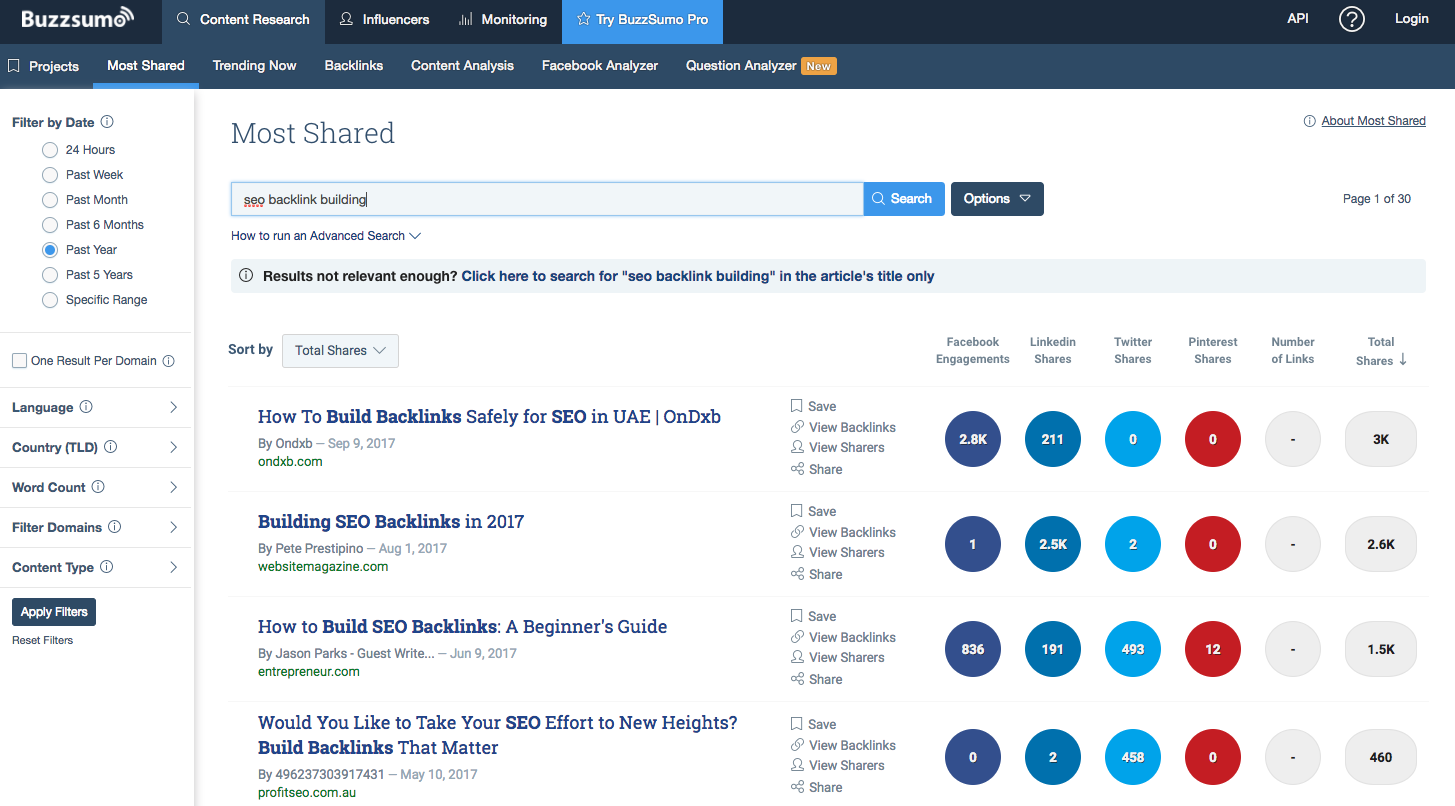
12. Ubersuggest: Use Ubersuggest to quickly find new keywords not available in the Google Keyword Planner. You’ll uncover tons of keyword ideas for SEO, PPC, and content marketing campaigns.
Landing Pages
13. WordPress: If you’re already using WordPress for your website or blog then the fastest and cheapest way to get landing pages going is to simply create a new page. This will give you the ability to direct your marketing campaigns to your new dedicated page.

Blogging
14. Blogger: Millions of blogs are built on Blogger (by Google) because of its easy-to-use templates that enable you to get a blog up and running in no time. Other boons for your blog include AdSense integration, built-in analytics plus Google analytics plugin, and storage for thousands of posts, photos, and more.
15. Medium: While Medium isn’t necessarily a tool, it is however, a great launching pad to start blogging from as there’s already a highly engaged audience built into the website.
With topics ranging from marketing best practices to interior design, you’re sure to find an audience seeking out topics around your niche. One of their newest features is an email newsletter where you can get in touch with your followers. How cool is that?!

16. WordPress: Not much needs to be said here as WordPress is generally the go-to for building a robust blog. However, what we love is the diversity of templates, widgets, and plugins that provide not only a competitive edge, but a way to clearly differentiate your blog’s look and feel.
Video
17. Wistia: After putting in all the time and effort to create a beautiful and effective video you want a platform that’s going to aid your marketing goals.
With Wistia it’s a marketers dream because the video player keeps people on your page, and can even send them to your desired next destination. Other great features are branding customization, call-to-action buttons, email capture, heatmapping to view trends, and more.
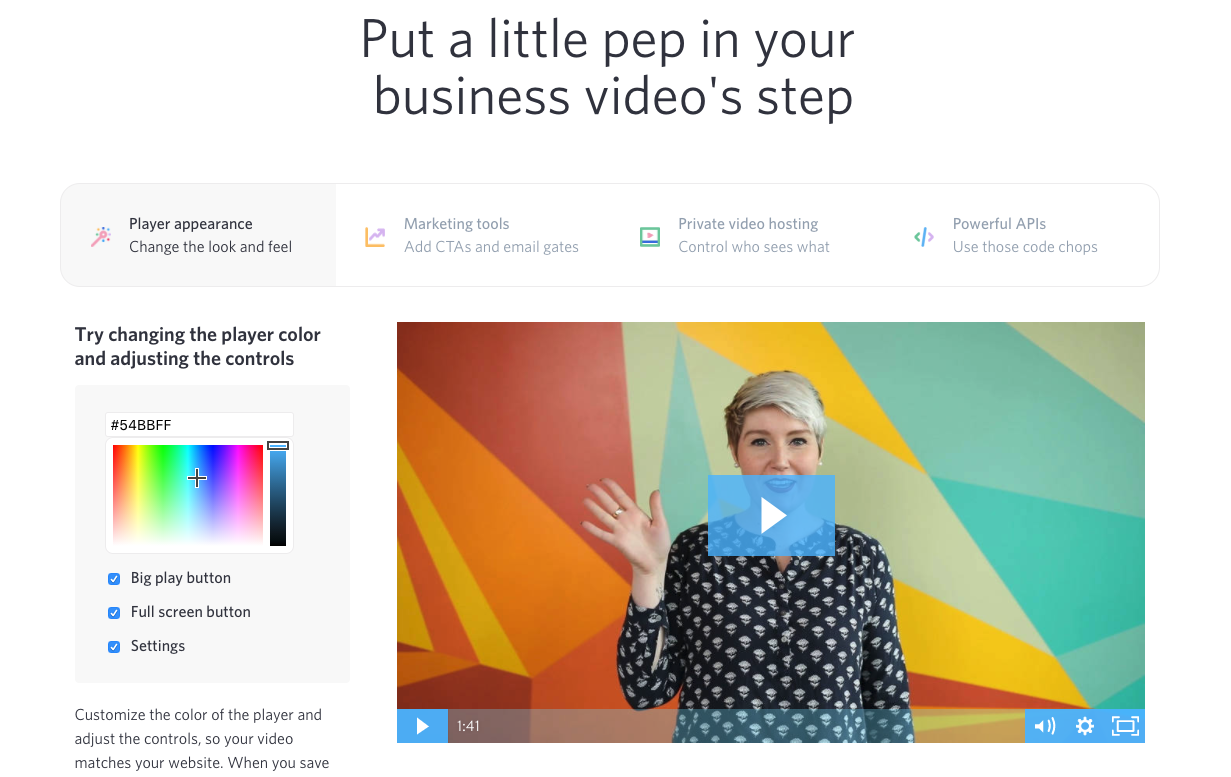
Others:
Website Analysis Tools
18. Above the Fold SEO Audit: Google scores your digital landscape according to SEO, mobile, social, usability, and many more. Knowing how you score is vital to your internet marketing effectiveness. We’ll deliver a full SEO audit of your website.
19. Website Grader: A great resource to receive immediate feedback on the strength and performance of your website, as well as tips on how to improve SEO, speed, security, and mobile performance.

20. Quicksprout: A full scope tool for website auditing, social media and competitor analysis.
Website Optimization
21. Hotjar: Heatmapping your website is an effective way to understand what users want, care about, and interact with on your website through visual representations of their clicks, taps, and scrolling behavior.
SEO
22. Open Site Explorer: Use Moz’s tool to determine your domain and page authority, incoming link sources, and a competition comparison. You can receive three free reports daily.
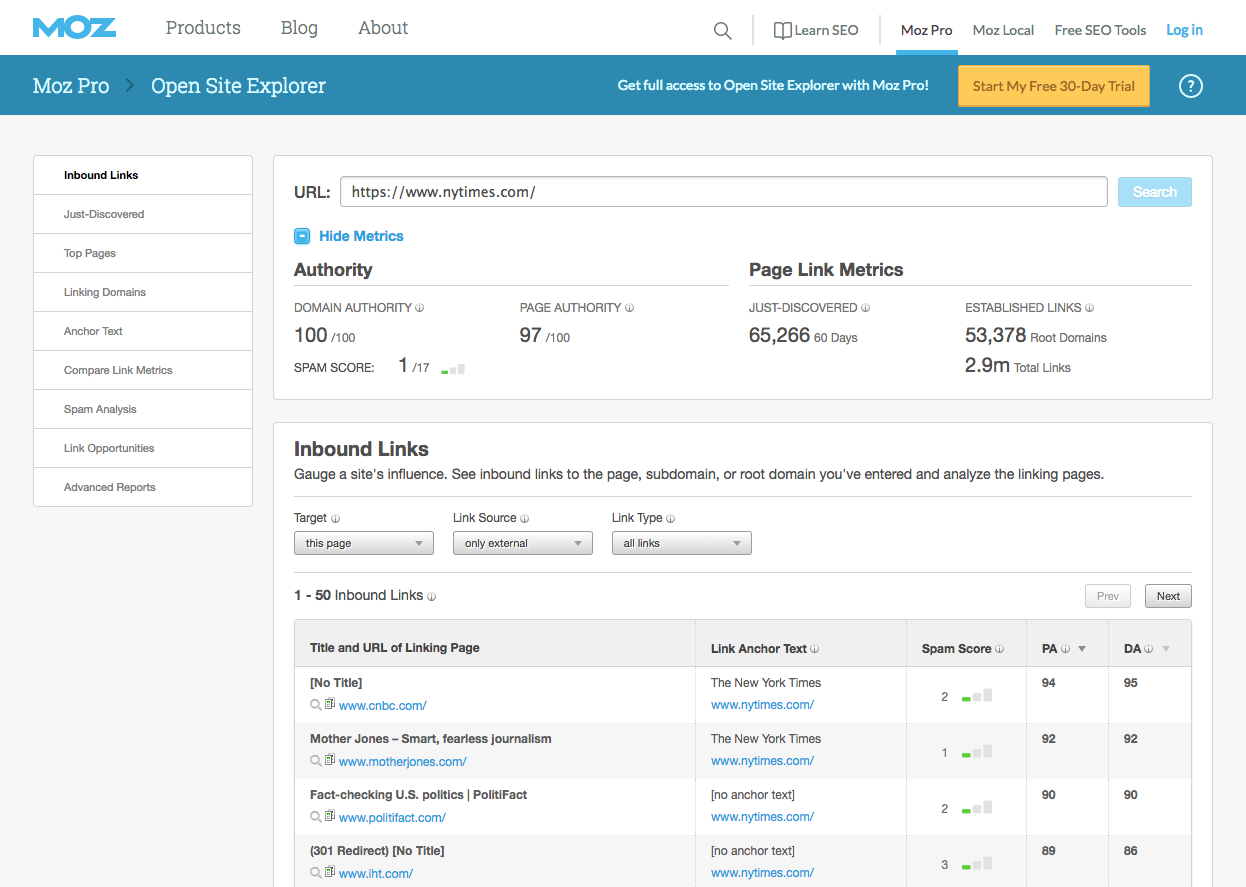
Other:
Email Marketing
23. Mailchimp: As an email marketing provider Mailchimp provides a very robust service. However, if you’re just starting to build your list and strategy their free option gives all the bells and whistles you’ll need.
If you have 2,000 subscribers, you can send up to 12,000 emails per month that comes with automation, sign up forms, modern templates, and data insight.
Project Management
24. Trello: Keep your team organized with Trello’s visual project management solution. With the ability to add team members, app integrations, comments, attachments, images, and set deadlines you’re able to keep every detail of a project in one place.

Other:
Communication
25. Slack: Eradicate the black hole that is searching through your email inbox with Slack. It’s an amazing internal company communication tool where you can message between employees, store information, upload attachments, and integrate other apps and tools you use daily. All done in a fun and modern way (with lots of emojis and gifs)!
CRM
26. Streak: For anyone looking to keep their CRM and email in one place should turn to Streak for Gmail. It’s an awesome and simple tool to manage and track current deals, especially if doing it on a smaller scale.

Lead Generation
27. SumoMe: They offer tools to automate site growth through non-intrusive pop ups where you can offer lead magnets to collect emails and social followers. The free version offers limited customization, however it’s a great place to start building your email lists.
Other:
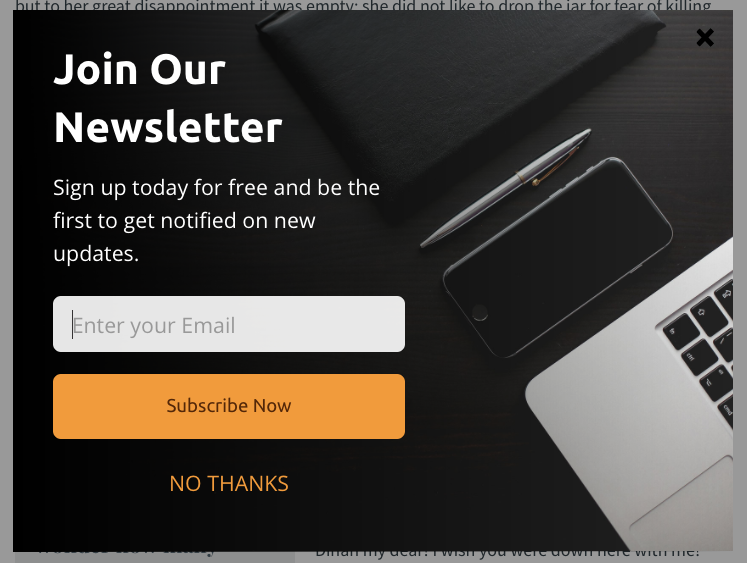
Why Going Cheap on Your Branding Is One of the Worst Mistakes You Can Make

Going cheap on your brand development could not only lead to a disconnect with potential customers, but could also result in your company shutting its doors as a result of low sales.
Your brand has a life.
Believe it or not, this thing you’ve created has legs to stand on, living and breathing every day. While this may sound high-minded, statistics prove otherwise. According to a study compiled by Bop Design, 54 percent of people don’t trust brands. But for those who do, 64 percent cite sharing a common bond with the brand as their primary reason for following or purchasing from them.
Why is this the case? Because your brand is your business’s first impression, and if done poorly, possibly the last. To some, branding seems like a luxury investment (and in some cases, this is true). However, going cheap on your brand development could not only lead to a disconnect with potential customers, but could also result in your company shutting its doors as a result of low sales. It’s a nightmare scenario for most entrepreneurs, which is why I’m going to go over a few reasons why investing in your brand is one of the wisest investments you could make.
A story you can sink your teeth into.
Breathe life into your business with a brand story or mission statement. Let’s be honest, coming up with your brand’s story is not an easy task. It’s going to take a lot of self-reflection and doubt, running through your purpose as to why your business exists in the first place. Additionally, this mantra will be what dictates every piece of copy or content your company puts out, creating a skeleton of how your voice will sound.
Let’s look at Whole Foods. The company could have created a wholesome-looking logo to lure people through its doors, but the multi-national retailer takes careful measures to back up its introduction to consumers. The brand has built a foundation of offering healthy and nutritious foods, and this foundation informs every marketing initiative and company development. From offering in-store educational experiences to teach consumers about food and emerging brands to getting involved in community-building programs through donating food to shelters and supporting local vendors, Whole Foods doesn’t just view its brand story as a marketing ploy, but leans on its pillars to guide the brand forward.
As Kissmetrics points out, there’s an actual science to what we deem as an authentic brand story. This breaks down to what’s essentially called neural coupling, or the emotional connection we feel when hearing a story. However, reaching this point might not be easily solved on your own, especially if you’re in a time crunch to launch.
While it’s up to you to have an agency or consulting firm take over your entire branding objectives, a lot of this is going to come from you. It’s not a bad idea to gain an outside perspective from someone to ask you the tough questions on why you started your business and what it represents, as well as where exactly you want it to head. The love you feel for what you’ve created is something most will understand, which is why having a third party pull the beauty of that out of you and translate it in a way others can comprehend is vital.
Because once you release your brand to the outside world, the perception of what it represents no longer belongs to only you anymore.
Your brand is more than just a logo.
A common misconception by novices in the branding world is making the assumption that a logo and a brand are synonymous. While your logo is one of the most important visual assets for your company — it is just the beginning. From there, you need bring your brand to life by embodying your values through marketing initiatives, product development and customer experience enhancements. Your brand’s goal is to represent an idea or shared truth between you and your audience, and that shared truth should permeate into the ethos of your business. It’s a common bond that drives towards a specific mission, which is something you’re going to miss the mark on by simply going for a cheap logo with the idea you’ll fix it later on.
When it comes to your logo, this symbol is going to represent an ethos that reflects upon how your company is aiming to change the world. Take the Whole Foods logo, for example. Many consumers in every major market across the country not only instantly recognize the green Whole Foods font, but new consumers also immediately recognize what the Whole Foods brand stands for thanks to the homage its logo pays to fruit and natural foods.
There’s plenty of places you can get a quality logo that won’t break the bank (I recommend checking out Deluxe). Remember, your logo is literally going to be everywhere your company is, so make it worth the ink it’s printed on. Plus, when done right, your logo is going to serve the purpose of telling your brand’s story without saying a word. So you have your logo … now what?
People talk, so you should listen.
How your brand is going to interact with the outside world will largely dictate the success of your company. From trade shows to social media, every interaction can give a valid perspective on who your company actually is. As Pew Research notes, more than 68 percent of all U.S. adults are on social media, so the potential amount of feedback you might receive could be tremendous.
Your brand is going to represent that universal truth you share with your consumers. Although discovering this is going to be tough, the rewards will be tremendous. People will no longer just be fans, but evangelists for what you’re about. Which begs the question: Are you ready to not just tell your story, but make it one that can stand the test of time?
About Andrew Medal: He is the founder of creative digital agency Agent Beta. He has helped organizations like the California Education Department, Proctor & Gamble, Microsoft, Warner Bros. and Inc. Magazine.
